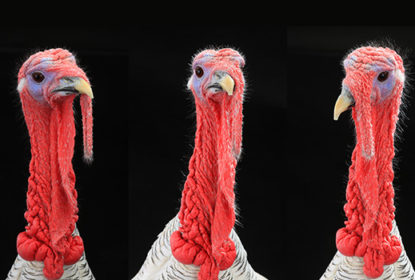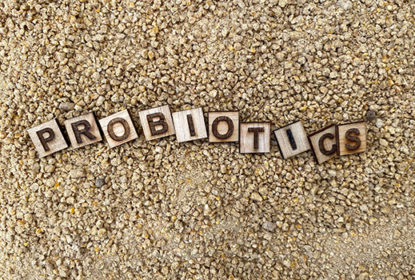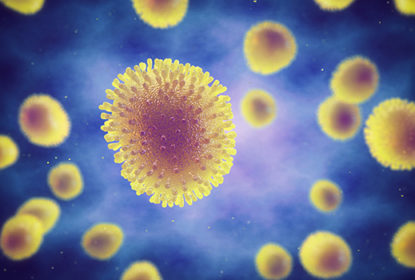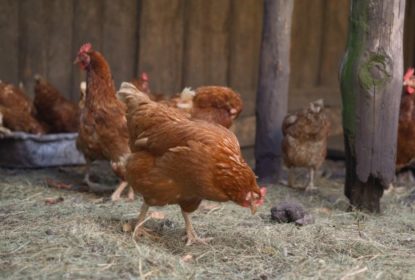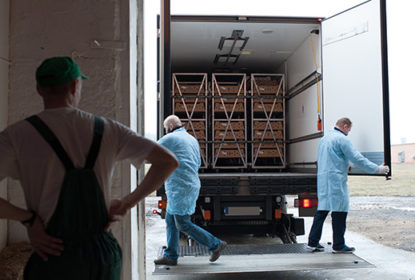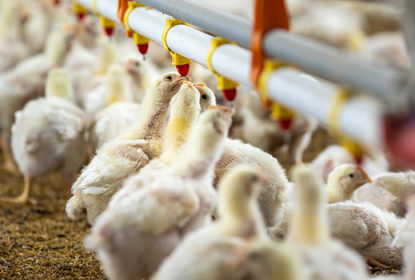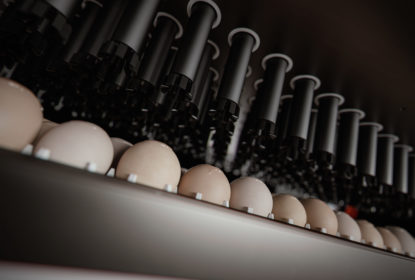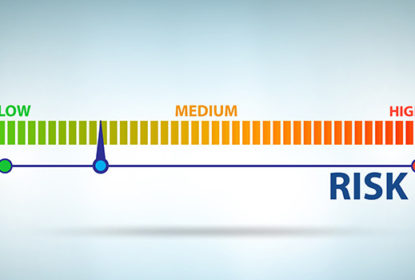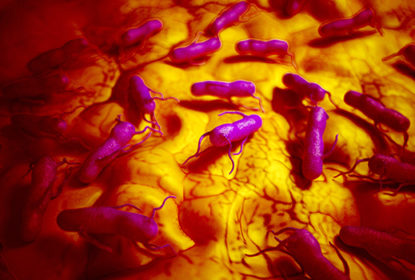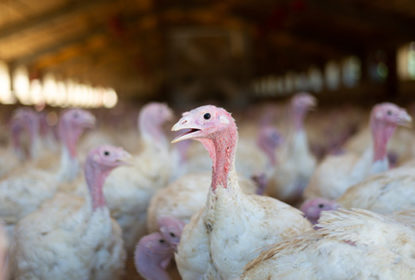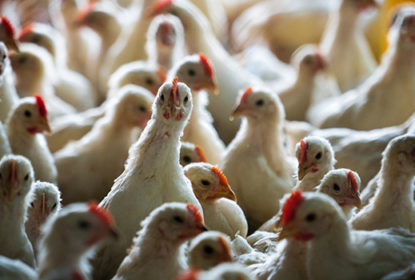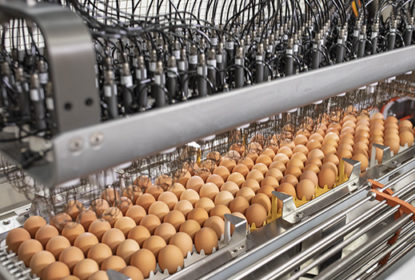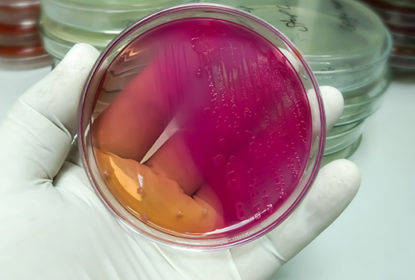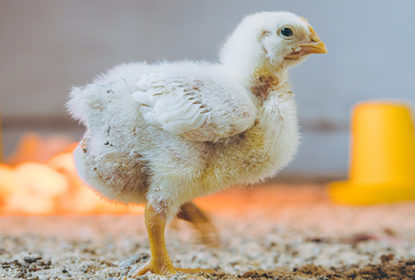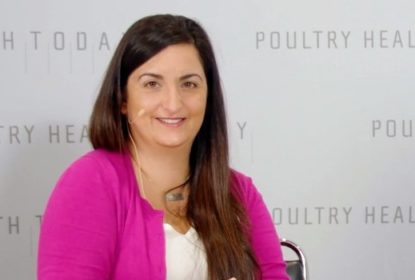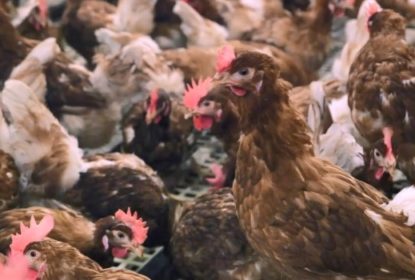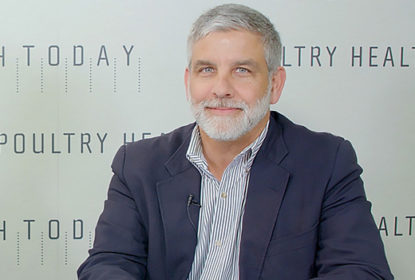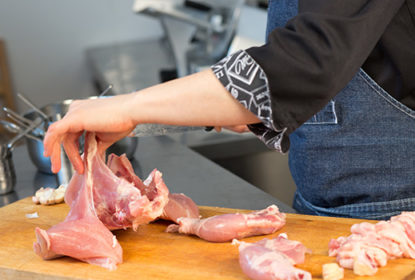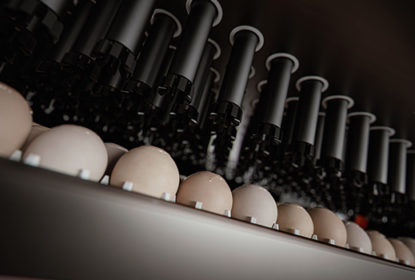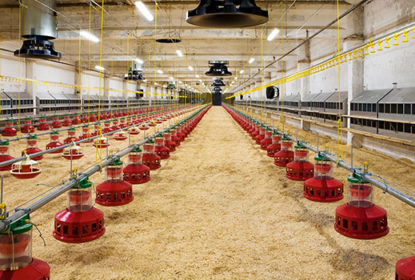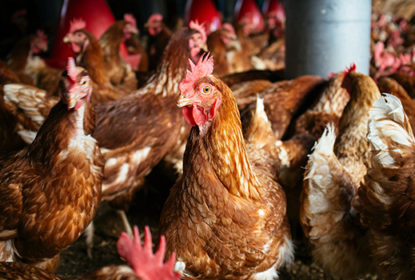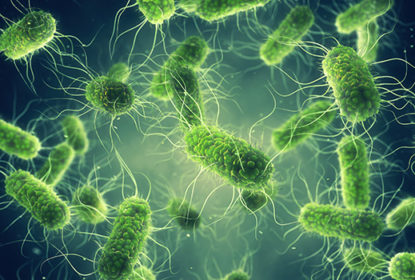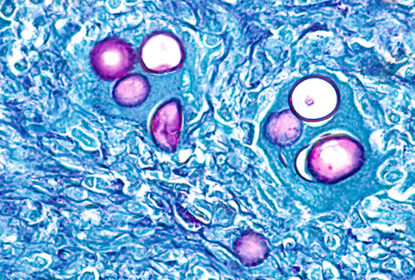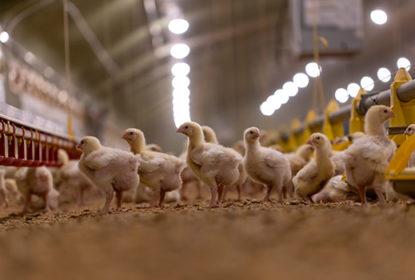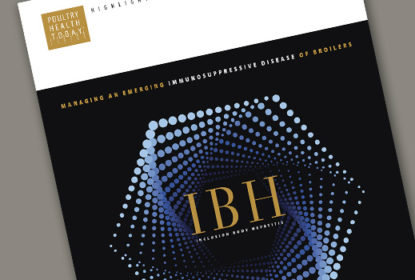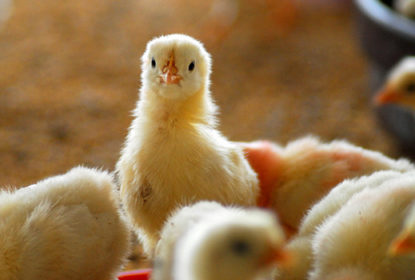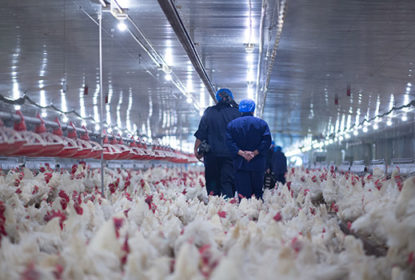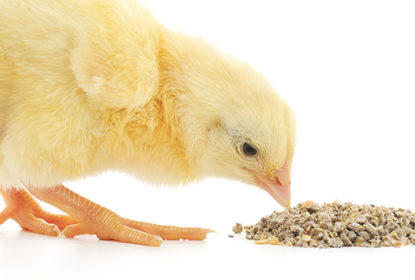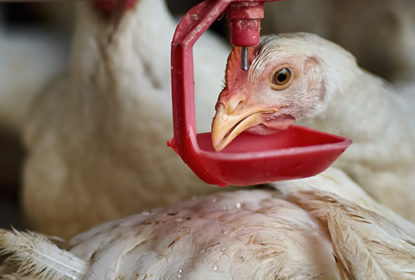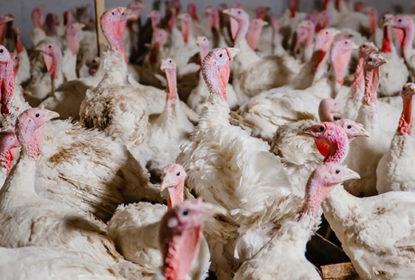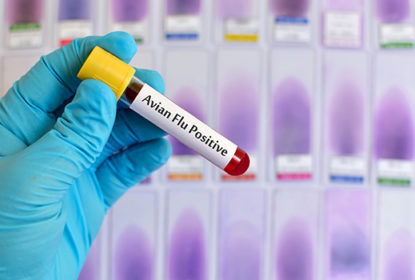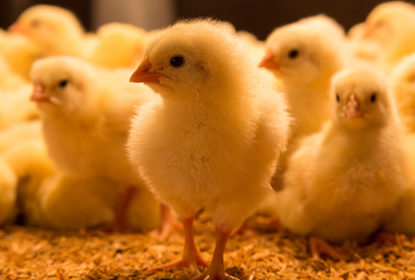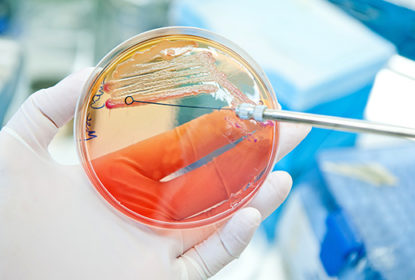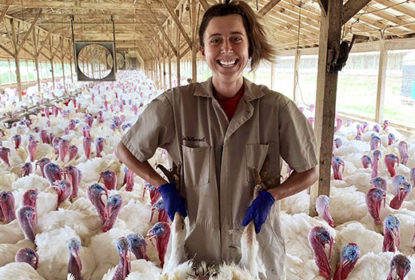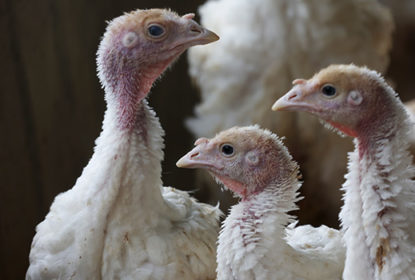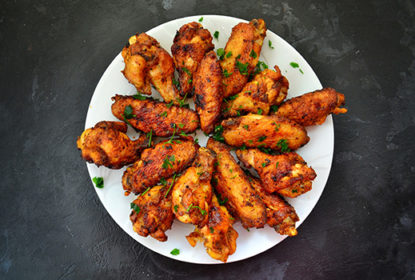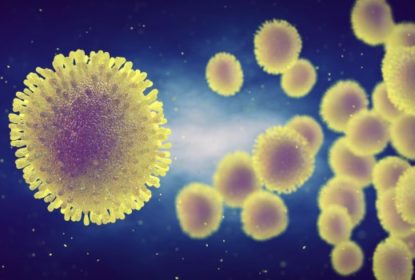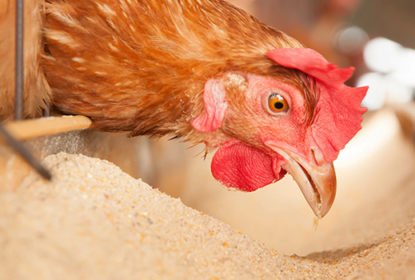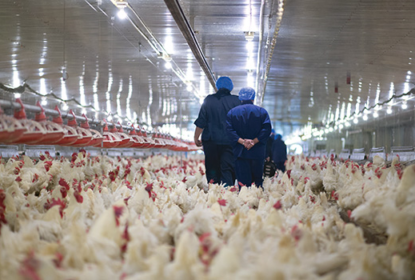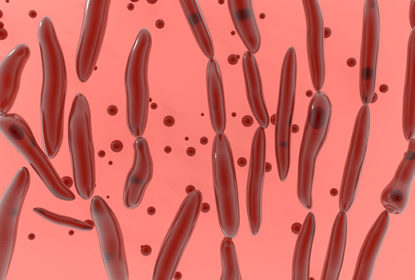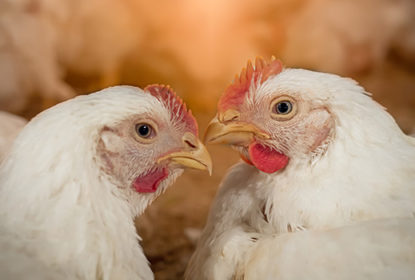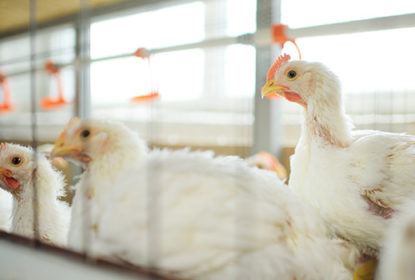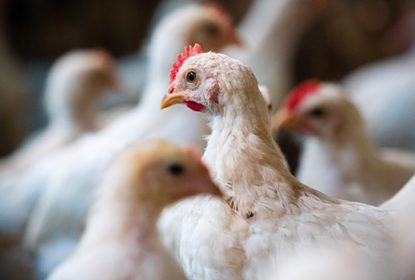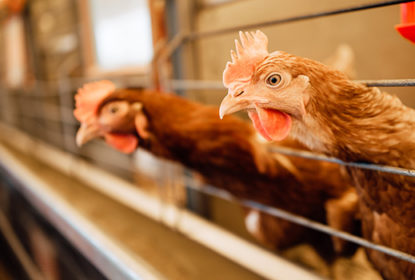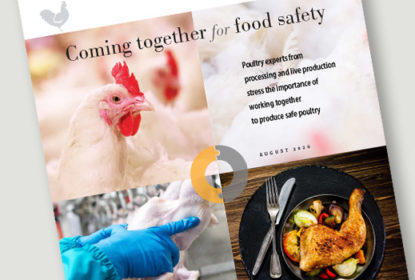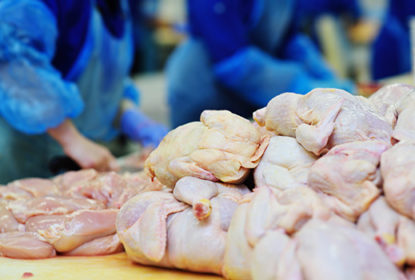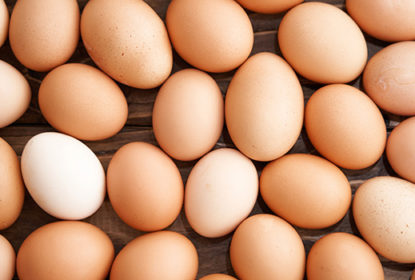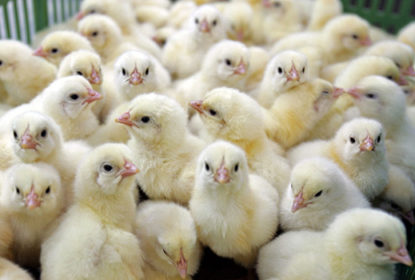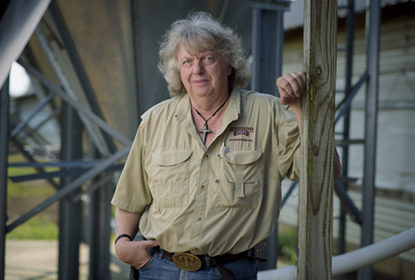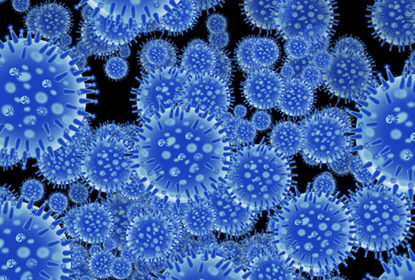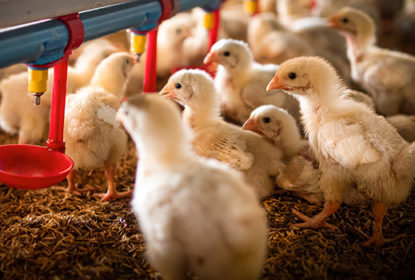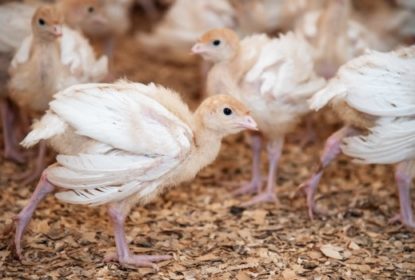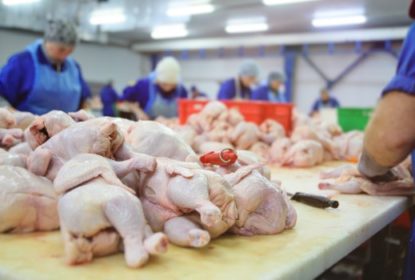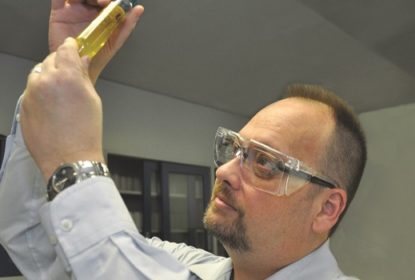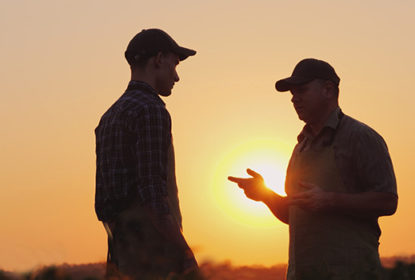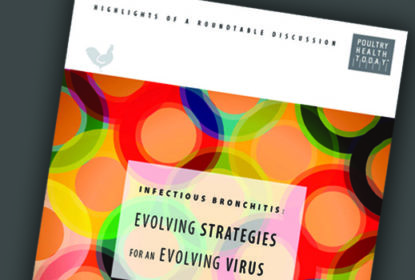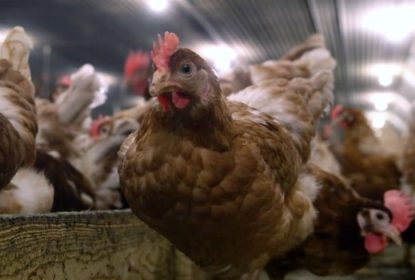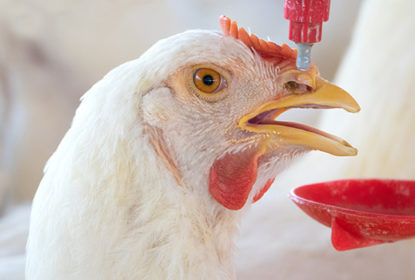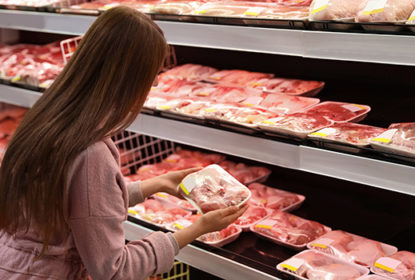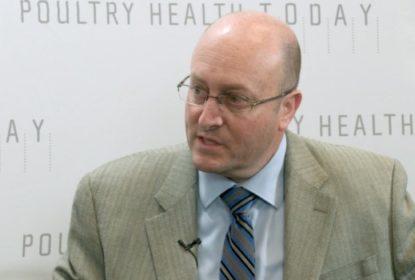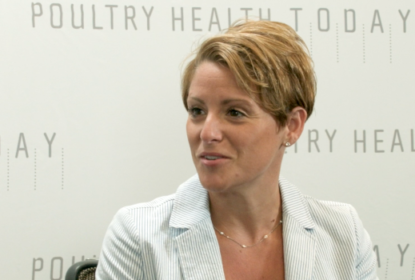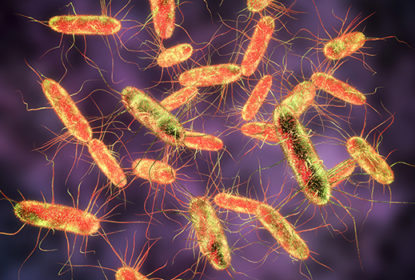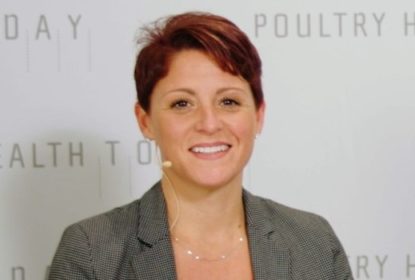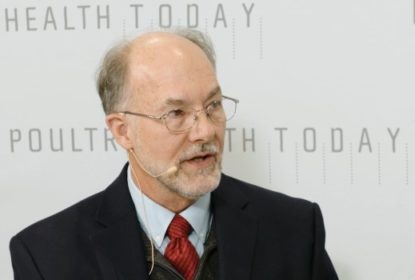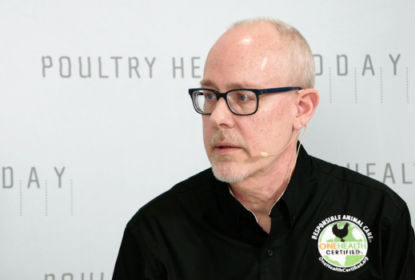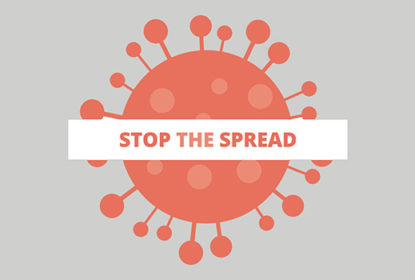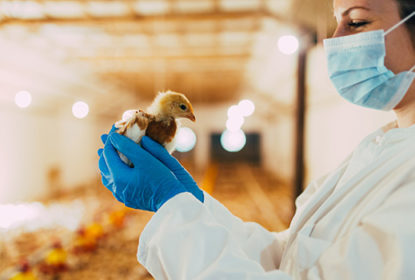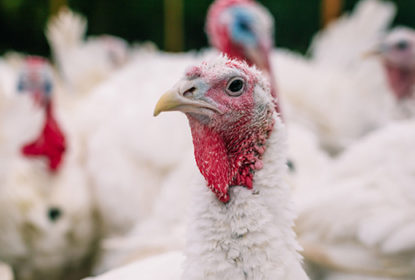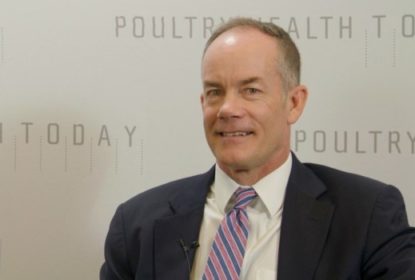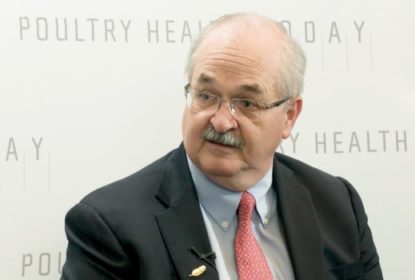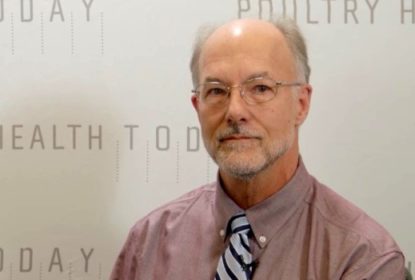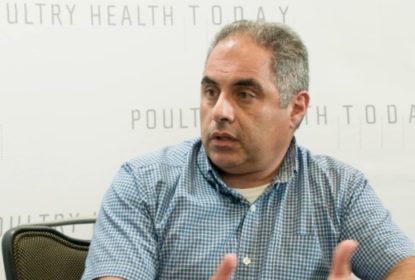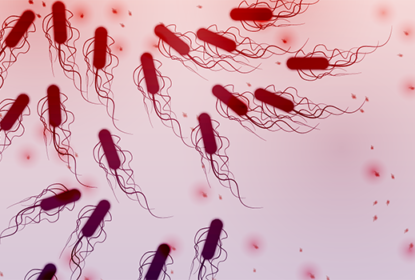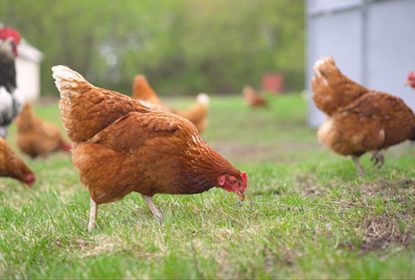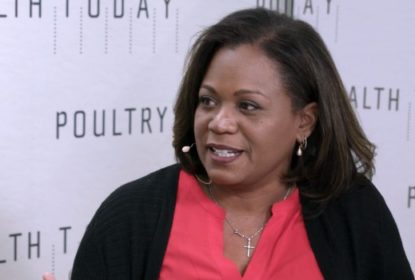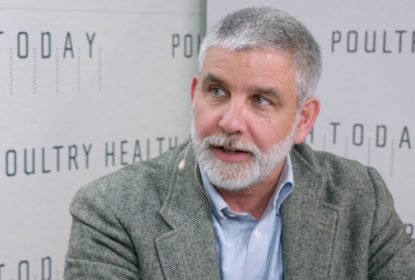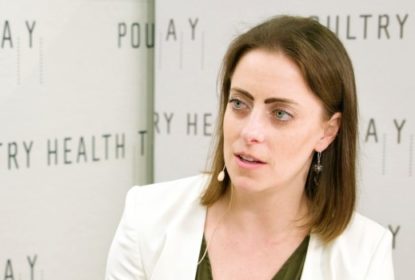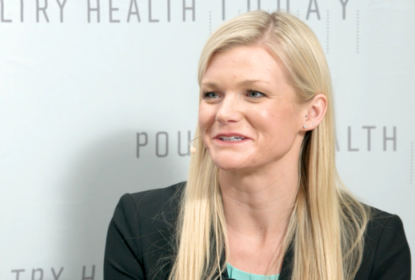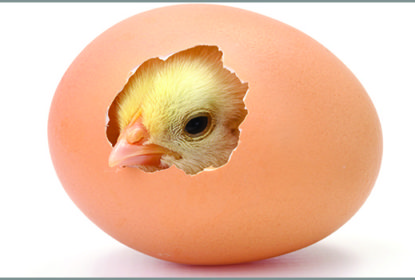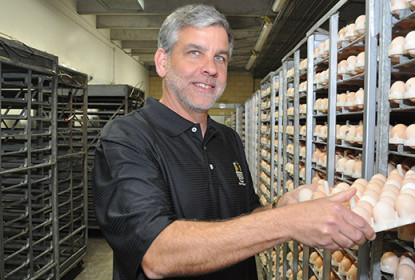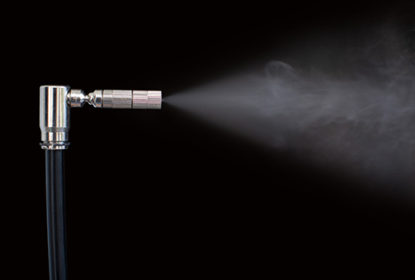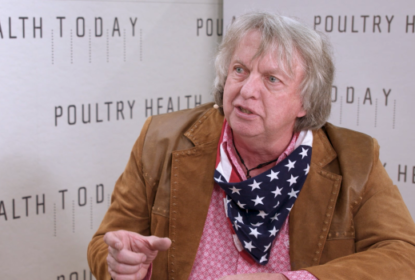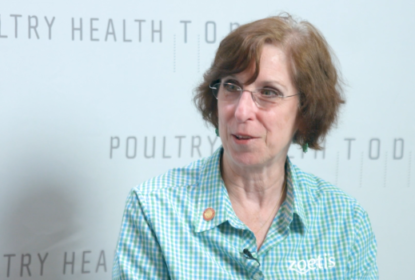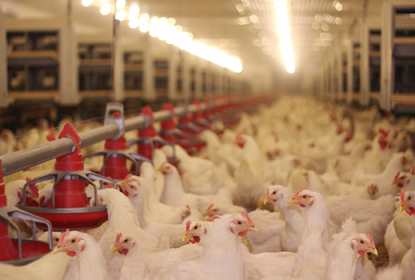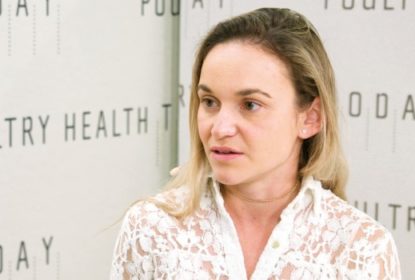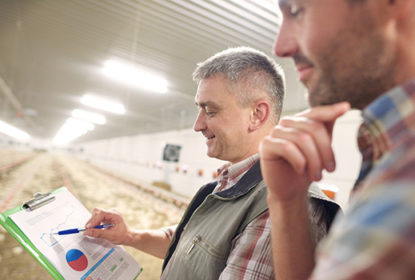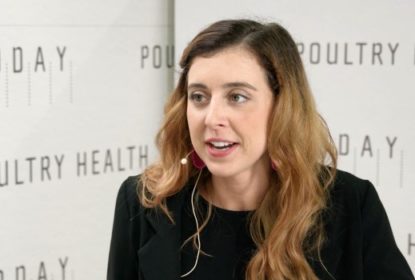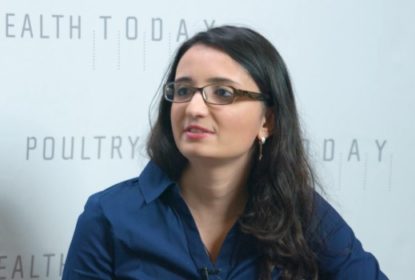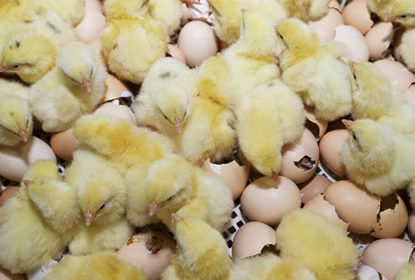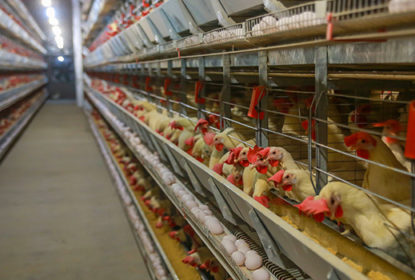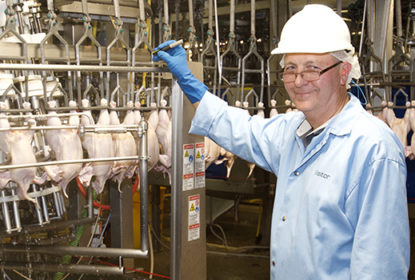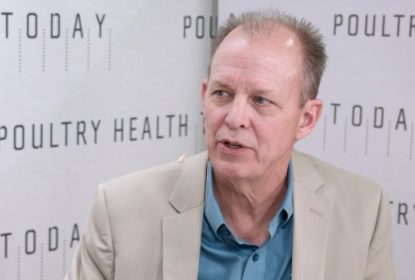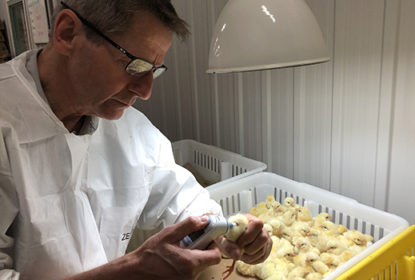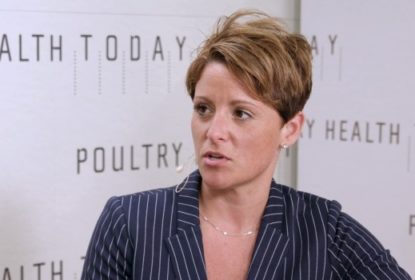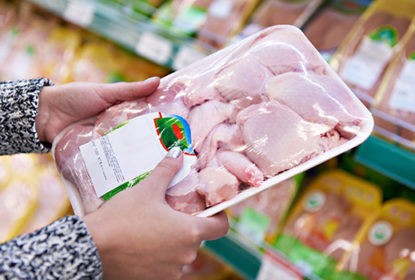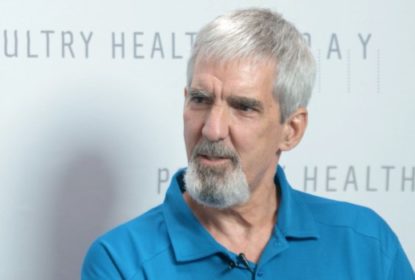Category Archive: Flock welfare, Global TOP NEWS, Infectious Diseases, PHT GLOBAL, PHT US, TOP NEWS
... Managing protozoal diseases in turkeys: There’s a lot we need to learn
Dec 27, 2022Jennifer GrullonComments Off on Managing protozoal diseases in turkeys: There’s a lot we need to learn
Three experts from research, production and industry share their experiences and offer insights for addressing protozoal diseases in turkeys.
Flock welfare, Global TOP NEWS, Infectious Diseases, Interviews, News, PHT GLOBAL, PHT US, Podcast, TOP NEWS, Videos
... Back-to-basics for managing health of cage-free pullets
Dec 26, 2022Jennifer GrullonComments Off on Back-to-basics for managing health of cage-free pullets
Poultry producers with cage-free pullet systems should go back to the basics of bird management to keep their flocks healthy and productive.
Antibiotic-free, Biosecurity, Global TOP NEWS, Hatchery, Interviews, News, PHT GLOBAL, PHT US, Podcast, TOP NEWS, Videos
... Automation key to ensuring sanitation in ‘no antibiotics ever’ systems
Dec 25, 2022Jennifer GrullonComments Off on Automation key to ensuring sanitation in ‘no antibiotics ever’ systems
Labor shortages in hatcheries mean that to ensure appropriate levels of sanitation in “no antibiotics ever” production, wholesale automation is likely to be required.
Biosecurity, Flock welfare, Global TOP NEWS, Interviews, News, PHT GLOBAL, PHT US, Podcast, Research, TOP NEWS, Videos
... Circulation fans reduce severity of footpad dermatitis
Dec 22, 2022Jennifer GrullonComments Off on Circulation fans reduce severity of footpad dermatitis
Footpad dermatitis causes significant foot problems for broilers, which adversely affects bird welfare and the market for broiler paws, according to research from the University of Maryland.... Nutritionist: Understanding probiotics is key to managing them effectively in poultry
Dec 22, 2022Jennifer GrullonComments Off on Nutritionist: Understanding probiotics is key to managing them effectively in poultry
With the ever-increasing shift to “no-antibiotics-ever” (NAE) production, probiotics have become more common in poultry diets, said Elizabeth Bobeck, PhD, a nutritional immunology expert and...... Why new HPAI variants continue to emerge
Dec 19, 2022Jennifer GrullonComments Off on Why new HPAI variants continue to emerge
The frequency of highly pathogenic avian influenza (HPAI) outbreaks is on the increase in the US with 6 of the past 8 years experiencing some form of HPAI.... Researchers address producer FAQs around cage-free egg production
Dec 19, 2022Jennifer GrullonComments Off on Researchers address producer FAQs around cage-free egg production
The US egg industry is in the process of transitioning to cage-free egg production, but many questions remain about the best practices and facilities for these types of production systems.... Distinctive condition affects layers as well as turkeys, broilers
Dec 15, 2022Jennifer GrullonComments Off on Distinctive condition affects layers as well as turkeys, broilers
A disease commonly seen in turkey and broiler flocks can also affect layers, meaning that producers should look out for its distinctive signs.... Bugs should be a key focus of biosecurity in controlling turkey disease
Dec 15, 2022Jennifer GrullonComments Off on Bugs should be a key focus of biosecurity in controlling turkey disease
Producers should play close attention to insect control in their poultry houses to avoid cases of turkey coronavirus enteritis (TCE).... How effective IBV surveillance can prevent ‘overvaccination’
Dec 15, 2022Jennifer GrullonComments Off on How effective IBV surveillance can prevent ‘overvaccination’
Consistent surveillance and analysis of infectious bronchitis virus (IBV) at poultry production facilities can guard against “overvaccination” — where too much vaccine virus in the environment...... Shedding light on LED lamps and dimmers: They’re not all a match
Dec 15, 2022Jennifer GrullonComments Off on Shedding light on LED lamps and dimmers: They’re not all a match
Getting the correct lighting is important in poultry houses to help maximize the birds’ genetic potential; however, too often there’s a disconnect between the LED lamps and the dimmers in...... Vegetative buffers yield many benefits for poultry farms
Dec 15, 2022Jennifer GrullonComments Off on Vegetative buffers yield many benefits for poultry farms
Vegetative buffers offer aesthetic, poultry-management and disease-control benefits to producers, in addition to showing the farm’s commitment to environmental stewardship.... Agreed indicators should help drive poultry-industry welfare
Dec 13, 2022Jennifer GrullonComments Off on Agreed indicators should help drive poultry-industry welfare
Using key welfare indicators (KWIs) can help fill a communication gap around welfare progress in the US poultry industry.... Study examines game camera use on poultry farm for biosecurity
Dec 09, 2022Jennifer GrullonComments Off on Study examines game camera use on poultry farm for biosecurity
Inexpensive game cameras installed on turkey farms can reveal important biosecurity information, but it comes with some caveats, according to researchers at the University of Minnesota.... UMN expert: Transparency, communication keys to mitigating the risks of HPAI
Dec 07, 2022Jennifer GrullonComments Off on UMN expert: Transparency, communication keys to mitigating the risks of HPAI
The US has a long history of effective disease control and has eradicated or remained free of many pests and agents even as they remain endemic in other parts of the world, said Carol Cardona, DVM,...... Farm mortality issues highlight importance of checking water supply
Dec 07, 2022Jennifer GrullonComments Off on Farm mortality issues highlight importance of checking water supply
Producers need to be alert to the dangers of drinking-water toxicity issues, according to a senior industry veterinarian.... NAE producers need to focus on Eimeria oocysts for more effective control of coccidiosis, necrotic enteritis
Dec 06, 2022Jennifer GrullonComments Off on NAE producers need to focus on Eimeria oocysts for more effective control of coccidiosis, necrotic enteritis
By Don Waldrip, DVM, Senior Technical Service Veterinarian, Zoetis... Vaccinating for Marek’s? Don’t be thrown off by PFU levels
Dec 02, 2022Jennifer GrullonComments Off on Vaccinating for Marek’s? Don’t be thrown off by PFU levels
Poultry veterinarians should not get hung up on the level of plaque-forming units (PFUs) to determine the strength of recombinant Marek’s vaccines, according to Isabel M. Gimeno, DVM, PhD,...... Coccidiosis: An old problem with some new challenges
Dec 01, 2022Jennifer GrullonComments Off on Coccidiosis: An old problem with some new challenges
Coccidiosis in broiler houses remains a nagging challenge. While clinical manifestations are rare, it’s the subclinical condition that impacts the flock through poor feed efficiency and reduced...... UMN training program focuses on poultry company decision-making, during AI outbreaks
Nov 30, 2022Jennifer GrullonComments Off on UMN training program focuses on poultry company decision-making, during AI outbreaks
The University of Minnesota offers a training program to help poultry companies understand and prepare for avian influenza outbreaks.... SFS program helping to identify best practices for HPAI risk assessments
Nov 30, 2022Jennifer GrullonComments Off on SFS program helping to identify best practices for HPAI risk assessments
The University of Minnesota’s Secure Food Systems team develops and publishes science-based risk assessments for the movement of poultry products from monitored (uninfected) premises in control...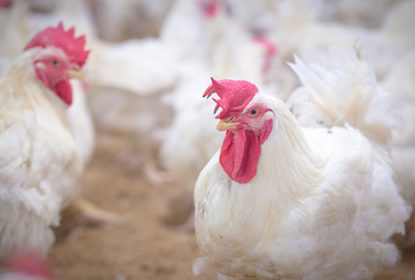
Flock welfare, Global TOP NEWS, Interviews, News, PHT GLOBAL, PHT US, Podcast, Research, TOP NEWS, Videos
... Environmental enrichments increased broiler activity in study
Nov 25, 2022Jennifer GrullonComments Off on Environmental enrichments increased broiler activity in study
Environmental enrichments in broiler houses may improve bird welfare by increasing natural behaviors, according to a University of Maryland study.... Study exposes Salmonella-contamination risks of integrated broiler production
Nov 22, 2022Jennifer GrullonComments Off on Study exposes Salmonella-contamination risks of integrated broiler production
Integrated broiler producers in Europe pose a risk of transmitting and maintaining clones of Salmonella throughout the production chain, according to researchers in Spain.... Vaccine strategy in cage-free layers requires new mindset
Nov 16, 2022Jennifer GrullonComments Off on Vaccine strategy in cage-free layers requires new mindset
By Daniel Wilson, DVM, Founder and Lead veterinarian, Wilson Veterinary Company, Indianapolis, IN... HPAI pushes holiday turkey prices to record highs
Nov 15, 2022Jennifer GrullonComments Off on HPAI pushes holiday turkey prices to record highs
The widespread outbreak of Highly Avian Pathogenic Avian Influenza (HPAI) across the US is expected to push up the cost of turkeys to record highs this holiday season. What does CoBank say about the...... Home for the holidays? Poultry vet urges ‘aseptic technique’ in the kitchen
Nov 11, 2022Jennifer GrullonComments Off on Home for the holidays? Poultry vet urges ‘aseptic technique’ in the kitchen
By Robert O’Connor, DVM, MAM, Senior vice president, Foster Farms... Inclusion body hepatitis re-emergence prompts fresh look at control strategies
Nov 10, 2022Jennifer GrullonComments Off on Inclusion body hepatitis re-emergence prompts fresh look at control strategies
The US broiler industry is seeing a re-emergence of inclusion body hepatitis, a deadly disease that can strike with little warning. Take a look at our special report.... Long-term control for IBH includes vaccines, management protocols
Nov 03, 2022Jennifer GrullonComments Off on Long-term control for IBH includes vaccines, management protocols
Inclusion body hepatitis (IBH) remains a nagging issue for broiler flocks, and it isn’t going away anytime soon.
Biosecurity, Food Safety, Global TOPICS, Interviews, News, PHT GLOBAL, PHT US, Podcast, TOPICS, Videos
... Don’t overlook feed biosecurity in efforts to manage Salmonella
Nov 02, 2022Jennifer GrullonComments Off on Don’t overlook feed biosecurity in efforts to manage Salmonella
Biosecurity in feed mills and on-farm feed storage should not be overlooked when it comes to managing the risk of Salmonella in poultry flocks, according to a turkey-health expert.... Five key points to consider when preparing to switch to in ovo vaccination
Nov 01, 2022Jennifer GrullonComments Off on Five key points to consider when preparing to switch to in ovo vaccination
A steady shift to in ovo vaccination in the Asia-Pacific region is encouraging many hatcheries there to improve practices and management in preparation for the switch.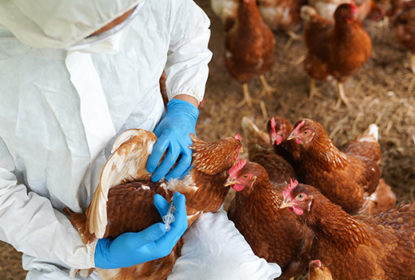
Diagnostics, Flock welfare, Global TOP NEWS, Infectious Diseases, News, PHT GLOBAL, PHT US, TOP NEWS
... Vaccines, biosecurity, management keys to keeping IBH in check
Oct 28, 2022Jennifer GrullonComments Off on Vaccines, biosecurity, management keys to keeping IBH in check
Inclusion body hepatitis can be a challenging disease, as the clinical signs are non-specific and there is no direct treatment. Consequently, producers rely on interventions such vaccinations.... E. coli implicated in layer gut disease
Oct 27, 2022Jennifer GrullonComments Off on E. coli implicated in layer gut disease
E.coli may be largely responsible for focal duodenel necrosis (FDN) in layer chickens, according to research presented at the 2022 International Poultry Scientific Forum (IPSF).
Flock welfare, Global TOP NEWS, Hatchery, Interviews, News, PHT GLOBAL, PHT US, Podcast, Research, TOP NEWS, Videos
... Study: Day length during brooding did not impact broiler performance
Oct 20, 2022Jennifer GrullonComments Off on Study: Day length during brooding did not impact broiler performance
Extended day length during the brooding period is thought to benefit broilers’ long-term performance and well-being. However, a University of Georgia study has re-evaluated that idea.... Reusing poultry litter may reduce antibiotic-resistant Salmonella
Oct 20, 2022Jennifer GrullonComments Off on Reusing poultry litter may reduce antibiotic-resistant Salmonella
Reusing poultry litter can help boost bird health and may help prevent the transfer of antibiotic-resistant Salmonella, scientists have discovered.... Improving Salmonella surveillance in turkeys
Oct 17, 2022Jennifer GrullonComments Off on Improving Salmonella surveillance in turkeys
High-profile Salmonella outbreaks in turkeys in recent years have shown the need for improved surveillance in the turkey industry.... Diagnostics for IBH start with subtle indicators
Oct 13, 2022Jennifer GrullonComments Off on Diagnostics for IBH start with subtle indicators
Inclusion body hepatitis (IBH) infections may not offer clear-cut clinical symptoms, but there are on-farm diagnostic measures that can yield early warnings.
Antibiotic-free, Flock welfare, Food Safety, Global TOP NEWS, Interviews, News, PHT GLOBAL, PHT US, Podcast, TOP NEWS, Videos
... Live-vaccine program a ‘must have’ to deal with cage-free E. coli challenge
Oct 10, 2022Jennifer GrullonComments Off on Live-vaccine program a ‘must have’ to deal with cage-free E. coli challenge
A higher risk of bacterial challenges in cage-free egg production means a live-vaccination program against Escherichia coli is a “must-have minimum” for flocks reared in alternative systems.... Managing layer health challenges as cage-free demand increases
Oct 07, 2022Jennifer GrullonComments Off on Managing layer health challenges as cage-free demand increases
In a special video from Poultry Health Today, experts from across the industry discuss the challenges facing producers who make the change from conventional systems to cage-free.... Breed may impact broiler response to Salmonella infection
Oct 06, 2022Jennifer GrullonComments Off on Breed may impact broiler response to Salmonella infection
Research at the University of Arkansas suggests broiler breed could affect birds’ immune response to Salmonella exposure, according to Shawna Weimer, PhD, director of the Center for Food Animal...
Biosecurity, Flock welfare, Global TOP NEWS, Infectious Diseases, News, PHT GLOBAL, PHT US, TOP NEWS
... HPAI prevention requires ‘buckle-up’ mentality to biosecurity
Oct 06, 2022Jennifer GrullonComments Off on HPAI prevention requires ‘buckle-up’ mentality to biosecurity
The only option for poultry farms to prevent an outbreak of highly pathogenic avian influenza (HPAI) is 100% adherence to biosecurity rules.... Anticoccidial sensitivity tests: Useful or not?
Oct 06, 2022Jennifer GrullonComments Off on Anticoccidial sensitivity tests: Useful or not?
By Philip A. Stayer, DVM, MS, ACPV, Corporate Veterinarian, Sanderson Farms, Inc.... No consensus on future success of Salmonella control for poultry industry
Oct 05, 2022Jennifer GrullonComments Off on No consensus on future success of Salmonella control for poultry industry
Opinions about the poultry industry’s future success in controlling Salmonella differ widely, judging by comments from panelists at a food-safety roundtable.... Replication, coverage vary among MD vaccination programs for long-lived birds
Oct 04, 2022Jennifer GrullonComments Off on Replication, coverage vary among MD vaccination programs for long-lived birds
DISCOVERIES: Marek’s disease (MD) vaccination programs for breeders and layers can vary significantly in the replication and coverage they provide, a finding that should be considered when planning...... COVID pandemic had some positive effects on poultry health and welfare
Sep 29, 2022Jennifer GrullonComments Off on COVID pandemic had some positive effects on poultry health and welfare
Management techniques adopted to cope with COVID-19 production challenges led to improvements in bird health and welfare for many poultry producers.
Flock welfare, Food Safety, Global TOP NEWS, Interviews, News, PHT GLOBAL, PHT US, Podcast, Research, TOP NEWS, Videos
... Salmonella serotypes are changing — monitor which ones are in your flock
Sep 28, 2022Jennifer GrullonComments Off on Salmonella serotypes are changing — monitor which ones are in your flock
It’s imperative for poultry producers and companies to know what strains of Salmonella may be circulating in their flocks, said Chuck Hofacre, president of the Southern Poultry Research Group in...... Tooling up for better disease protection through applied research
Sep 27, 2022Jennifer GrullonComments Off on Tooling up for better disease protection through applied research
Vaccines are powerful, widely used tools for managing poultry diseases. How can the industry keep pace with variant viruses and other challenges?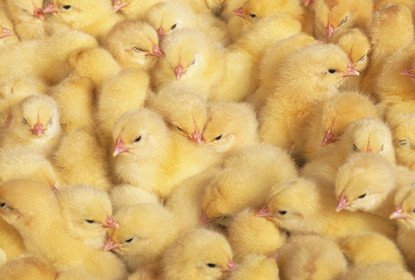
Flock welfare, Global TOP NEWS, Hatchery, Interviews, News, PHT GLOBAL, PHT US, Podcast, TOP NEWS, Videos
... Recombinant vaccines for poultry: How to maximize results
Sep 22, 2022Jennifer GrullonComments Off on Recombinant vaccines for poultry: How to maximize results
Proper vaccine handling, dosage and administration are key to ensuring thorough and effective coverage. That statement is particularly true when talking about recombinant-vector vaccines.... How to ensure successful installation of in ovo technology
Sep 20, 2022Jennifer GrullonComments Off on How to ensure successful installation of in ovo technology
In ovo vaccination is on the rise across the Asia-Pacific as producers recognize its benefits, but proper training and support are essential.... ILT vaccine choices: A closer look
Sep 20, 2022Jennifer GrullonComments Off on ILT vaccine choices: A closer look
With continued wild-type ILT challenges in the field, we are faced with a choice of two vaccine options with proven results — with different priorities affecting the final decision.... Best-management practices key to successful NAE broiler production
Sep 15, 2022Jennifer GrullonComments Off on Best-management practices key to successful NAE broiler production
With many poultry operations switching to no-antibiotics-ever (NAE) production, management and disease control have become even more critical components.... Avian flu likely to re-emerge and threaten US poultry flocks this fall
Sep 15, 2022Jennifer GrullonComments Off on Avian flu likely to re-emerge and threaten US poultry flocks this fall
US egg and turkey supplies took a hit from highly pathogenic avian influenza (HPAI) this spring as the wild-bird migration exposed domestic flocks to the virus.
Food Safety, Global TOP NEWS, Interviews, News, PHT GLOBAL, PHT US, Podcast, Research, TOP NEWS, Videos
... Study highlights risk of high Salmonella exposure, more persistent serotypes
Sep 10, 2022Jennifer GrullonComments Off on Study highlights risk of high Salmonella exposure, more persistent serotypes
Feed conversion takes a bigger hit in birds with higher Salmonella exposure, while Salmonella Reading outlasts other serotypes through the grow-out period, suggests new work from the University of...
Condemnations, Food Safety, Global TOP NEWS, Interviews, News, PHT GLOBAL, PHT US, Podcast, TOP NEWS, Videos
... USDA evaluating Salmonella-reduction steps along the poultry supply chain
Sep 08, 2022Jennifer GrullonComments Off on USDA evaluating Salmonella-reduction steps along the poultry supply chain
Almost 25% of US foodborne illnesses continue to be linked to poultry products. To get an accurate measure of product contamination, USDA is evaluating the poultry supply chain.... Monitoring hen movement in cage-free aviaries provides valuable feedback
Sep 06, 2022Jennifer GrullonComments Off on Monitoring hen movement in cage-free aviaries provides valuable feedback
Nearly 35% of laying hens in the US are now raised in cage-free environments, but while these environments offer more space and bigger colonies, the systems are more complex.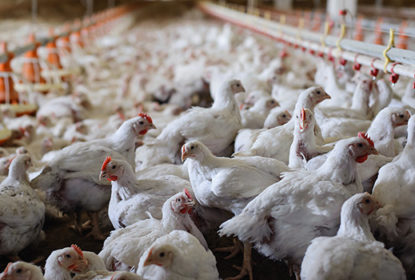
Diagnostics, Flock welfare, Global TOP NEWS, Infectious Diseases, News, PHT GLOBAL, PHT US, TOP NEWS
... IBH gaining more attention in broiler flocks as incidence, mortalities rise
Sep 01, 2022Jennifer GrullonComments Off on IBH gaining more attention in broiler flocks as incidence, mortalities rise
Inclusion body hepatitis (IBH) is not a new disease of poultry, but it’s quietly spreading to broiler flocks — initially with few clinical signs, followed by death in some flocks.... PHT Perspectives captures highlights of timely poultry health discussions
Aug 25, 2022Jennifer GrullonComments Off on PHT Perspectives captures highlights of timely poultry health discussions
Poultry Health Today has introduced a new editorial feature called PHT Perspectives, which provides quick-read highlights of recent webinars and roundtables organized by the editors.... Study shows modified-live vaccine can aid fight against Salmonella Infantis
Aug 24, 2022Jennifer GrullonComments Off on Study shows modified-live vaccine can aid fight against Salmonella Infantis
New research shows that using a modified-live Salmonella Typhimurium (ST) vaccine helps protect broilers against Salmonella Infantis, the most commonly-isolated serotype in chicken parts and...... Use ‘tools of discovery’ and all your senses to identify emerging poultry diseases
Aug 23, 2022Jennifer GrullonComments Off on Use ‘tools of discovery’ and all your senses to identify emerging poultry diseases
Emerging and re-emerging diseases can cause sudden, potentially catastrophic illness and death in commercial poultry flocks, said R.M. “Mick” Fulton, DVM, PhD, Michigan State University...... Cooling chickens with sprinklers has multiple benefits
Aug 18, 2022Jennifer GrullonComments Off on Cooling chickens with sprinklers has multiple benefits
By Tom Tabler, PhD, Extension Professor, Mississippi State University, Extension Service, Poultry Science Department, Mississippi State, Mississippi... New insights for managing coccidiosis in broilers
Aug 11, 2022Jennifer GrullonComments Off on New insights for managing coccidiosis in broilers
Despite industry advances, coccidiosis remains the leading intestinal health challenge in broilers. Poultry Health Today asked experts to share their latest insights and recommendations for managing...... Tuning up live-vaccine priming for infectious bursal disease and reovirus
Aug 11, 2022Jennifer GrullonComments Off on Tuning up live-vaccine priming for infectious bursal disease and reovirus
TOOLBOX, Issue 13: An interview with Kalen Cookson, DVM, MAM, Director of Clinical Research, Zoetis... Genomic technology sheds light on Salmonella serotypes in breeder flocks
Aug 04, 2022Jennifer GrullonComments Off on Genomic technology sheds light on Salmonella serotypes in breeder flocks
A technology called CRISPR-SeroSeq, which amplifies a section of the Salmonella genome, is helping paint a clearer picture of the serotypes circulating in breeder flocks.... ‘Reverse genetics’ may offer new IBV vaccine targets
Aug 04, 2022Jennifer GrullonComments Off on ‘Reverse genetics’ may offer new IBV vaccine targets
Researchers at The Pirbright Institute in the UK report that a recent study provides evidence that mutations in the genetic code for non-structural proteins “offer a promising way” to make...... Greater understanding needed before new coccidiosis vaccines come to fore
Aug 03, 2022Jennifer GrullonComments Off on Greater understanding needed before new coccidiosis vaccines come to fore
The use of recombinant vaccines can prove a valuable strategy against coccidiosis in poultry, but better understanding of host-parasite interactions and gut microbiology is needed.... Overheating soybean meal hurts gut integrity, broiler growth
Aug 01, 2022Jennifer GrullonComments Off on Overheating soybean meal hurts gut integrity, broiler growth
Improper heat treatment of soybean meal affects the intestinal integrity of broiler chickens and flock performance, according to a study by researchers at the University of Georgia.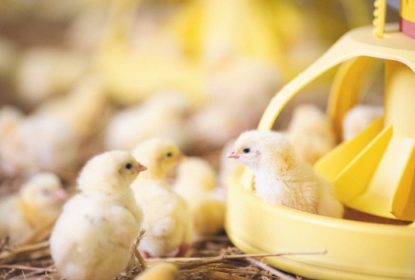
Flock welfare, Global TOPICS, Infectious Diseases, Interviews, News, PHT GLOBAL, PHT US, Podcast, Respiratory, TOPICS, Videos
... Why ‘vaccinated’ chickens still get infected with IBV — and what to do about it
Jul 26, 2022Jennifer GrullonComments Off on Why ‘vaccinated’ chickens still get infected with IBV — and what to do about it
While many vaccines and vaccination programs effectively protect against the highly contagious infectious bronchitis virus in poultry, outbreaks of the disease still occur in vaccinated flocks.
Flock welfare, Global TOPICS, Hatchery, Interviews, News, PHT GLOBAL, PHT US, Podcast, Research, Videos
... Light impacts behavior in cage-free aviaries
Jul 20, 2022Jennifer GrullonComments Off on Light impacts behavior in cage-free aviaries
Birds can move out of the reach of the workers’ hands in a multi-tier aviary system, so employees have to climb into the system to get to them. Researchers from Michigan State studied light...... Live vaccines are key to Salmonella-control programs — here’s why
Jul 19, 2022Jennifer GrullonComments Off on Live vaccines are key to Salmonella-control programs — here’s why
Immune responses to Salmonella infection are complex, but vaccination has become a key component of multi-step control programs. A new review of evidence to date suggests that live vaccines have...... Free booklet offers insights for addressing IBH in broilers
Jul 14, 2022Jennifer GrullonComments Off on Free booklet offers insights for addressing IBH in broilers
Poultry veterinarians throughout the US broiler industry are reporting a re-emergence of inclusion body hepatitis (IBH). The disease, caused by fowl adenovirus (FAdV), often strikes with little...... Marek’s study could lead to new management strategies in poultry
Jul 06, 2022Jennifer GrullonComments Off on Marek’s study could lead to new management strategies in poultry
New research has given scientists a greater understanding of the Marek’s disease virus (MDV) that could lead to new strategies for managing the widespread, immunosuppressive disease in poultry.... Survey shows US poultry industry’s evolving yet flexible approach to coccidiosis management
Jun 13, 2022Jennifer GrullonComments Off on Survey shows US poultry industry’s evolving yet flexible approach to coccidiosis management
After years of being an afterthought in many broiler-production schemes, coccidiosis vaccines have become the cornerstone for many control programs.
Flock welfare, Global TOPICS, Infectious Diseases, Interviews, News, PHT GLOBAL, PHT US, Podcast, TOPICS, Videos
... Poultry industry can learn from COVID-19
Jun 09, 2022Jennifer GrullonComments Off on Poultry industry can learn from COVID-19
Biosecurity is not sufficient to control avian coronaviruses like infectious bronchitis in commercial poultry, no matter how good it is, said Mark Jackwood, PhD, a molecular virologist and professor...... Marek’s disease control takes careful attention to detail
Jun 07, 2022Jennifer GrullonComments Off on Marek’s disease control takes careful attention to detail
The evolution of Marek’s disease virus (MDV) has increased the pathogen’s virulence. Besides the tumors MDV is known for producing, the virus can lead to a multitude of other problems.... Limiting E. coli transmission from hen to offspring
Jun 04, 2022Jennifer GrullonComments Off on Limiting E. coli transmission from hen to offspring
TOOLBOX: An interview with Henrik Christensen, PhD, DVSc, University of Copenhagen, on the effect of Poulvac E. coli on bird health, laying performance and hatching results.
Flock welfare, Food Safety, Global TOP NEWS, Interviews, News, PHT GLOBAL, PHT US, Podcast, Research, TOP NEWS, Videos
... ‘Competitive exclusion’ is potential benefit of live Salmonella vaccines in young birds
Jun 02, 2022Jennifer GrullonComments Off on ‘Competitive exclusion’ is potential benefit of live Salmonella vaccines in young birds
Live vaccines for Salmonella have been found to start offering protection within a few days of administration, acting “almost as a [form of] competitive exclusion,” said Chuck Hofacre, president...... Avian flu strain behind recent outbreaks related but not identical to 2014-15 strain
Jun 02, 2022Jennifer GrullonComments Off on Avian flu strain behind recent outbreaks related but not identical to 2014-15 strain
The US poultry industry is on high alert following reports of highly pathogenic avian influenza (HPAI) in both wild birds and commercial flocks in poultry-dense regions of the US market.... How to avoid performance drops when initiating coccidiosis vaccination
Jun 01, 2022Jennifer GrullonComments Off on How to avoid performance drops when initiating coccidiosis vaccination
TOOLBOX, Issue 11: An interview with Jon Schaeffer, DVM, Director of Poultry Veterinary Services, Zoetis... Special Report: New insights for managing coccidiosis in broilers
Jun 01, 2022Jennifer GrullonComments Off on Special Report: New insights for managing coccidiosis in broilers
Despite industry advances, coccidiosis remains the leading intestinal health disease of broilers. Poultry Health Today asked experts to share latest insights and recommendations for managing this...... Colibacillosis control in egg-laying chickens: A new tool in our toolbox
May 25, 2022Jennifer GrullonComments Off on Colibacillosis control in egg-laying chickens: A new tool in our toolbox
By Paul McMullin, MVB, MSc, DPMP, DiplECPVS, FRCVS, Consultant Veterinarian, Poultry Health International
Diagnostics, Flock welfare, Global TOPICS, Infectious Diseases, Interviews, News, PHT GLOBAL, PHT US, Podcast, Research, TOPICS, Videos
... Poor IBV vaccine performance in broiler study underlines need for surveillance
May 12, 2022Jennifer GrullonComments Off on Poor IBV vaccine performance in broiler study underlines need for surveillance
A whole-complex study of broiler breeders in Georgia found underwhelming infectious bronchitis vaccine performance – but with better surveillance and protocols, outcomes could be improved.... Salmonella Enteritidis in feed can be a source for broiler flocks
May 11, 2022Jennifer GrullonComments Off on Salmonella Enteritidis in feed can be a source for broiler flocks
The Southern Poultry Research Group created a challenge model to show how S. Enteritidis, can spread among birds when feed is contaminated and to help evaluate products that can eliminate or reduce...... California surveillance reveals genetic and seasonal changes in infectious bronchitis virus
May 01, 2022Jennifer GrullonComments Off on California surveillance reveals genetic and seasonal changes in infectious bronchitis virus
Genotypes of infectious bronchitis virus (IBV) found in California between 2012 and 2020 have seen a “major shift,” according to a study investigating patterns of IBV in the state.... In ovo administration of recombinant HVT vector vaccines ‘perfect combination’ of microbiology and engineering
Apr 27, 2022Jennifer GrullonComments Off on In ovo administration of recombinant HVT vector vaccines ‘perfect combination’ of microbiology and engineering
TOOLBOX, Issue 30: An interview with Alberto Giner, DVM, poultry technical manager, Zoetis on in ovo administration of recombinant HVT vector vaccines.... On-site PCR testing could aid smart antibiotic use in mycoplasmosis treatment
Apr 26, 2022Jennifer GrullonComments Off on On-site PCR testing could aid smart antibiotic use in mycoplasmosis treatment
Making use of polymerase chain reaction (PCR) testing on chicken farms can help tackle the problem of antibiotic overuse against mycoplasmosis in countries where this treatment approach is prevalent.... Turkey-farm study finds Salmonella Infantis prevalent
Apr 19, 2022Jennifer GrullonComments Off on Turkey-farm study finds Salmonella Infantis prevalent
Research studying Salmonella across one turkey producer’s farms found Salmonella Infantis to be by far the dominant serotype.... UK researchers: Watch for emerging, more infectious strains of avian flu virus
Apr 18, 2022Jennifer GrullonComments Off on UK researchers: Watch for emerging, more infectious strains of avian flu virus
According to research led by The Pirbright Institute, UK, infection with two strains of avian flu virus could lead to the emergence of a new strain with the potential to jump from birds to humans.... With avian flu outbreaks, even the Easter bunny is hunting for eggs
Apr 07, 2022Jennifer GrullonComments Off on With avian flu outbreaks, even the Easter bunny is hunting for eggs
The US egg supply is under pressure, first from the impact of Covid-19 and now due to outbreaks of highly pathogenic avian influenza (HPAI).... Interaction of modified-live and recombinant vaccines shows potential against viral diseases
Apr 06, 2022Jennifer GrullonComments Off on Interaction of modified-live and recombinant vaccines shows potential against viral diseases
Adding a modified-live vaccine (MLV) to recombinant vaccine programs against three important viral pathogens in poultry production can have a positive impact on outcomes, according to field work by...... US poultry producers commit to limiting antibiotics despite production slip
Apr 06, 2022Jennifer GrullonComments Off on US poultry producers commit to limiting antibiotics despite production slip
The number of birds in the US broiler industry raised without antibiotics slipped six points to 52% in 2020, according to the latest industry figures, exclusive to Poultry Health Today.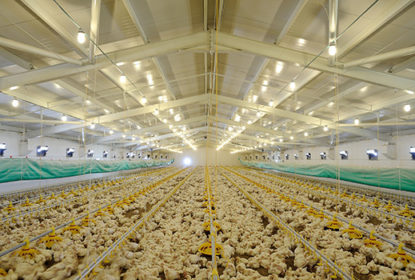
Biosecurity, Global TOP NEWS, Gut Health, Interviews, News, PHT GLOBAL, PHT US, Podcast, TOP NEWS, Videos
... Comparing necrotic enteritis litter models highlights performance impacts
Apr 06, 2022Jennifer GrullonComments Off on Comparing necrotic enteritis litter models highlights performance impacts
Reused litter from a previous NE challenge led to more severe subclinical performance impacts but fewer clinical signs of disease than in birds raised on fresh litter.... Tips for managing inclusion body hepatitis
Mar 25, 2022Jennifer GrullonComments Off on Tips for managing inclusion body hepatitis
TOOLBOX, Issue 27: An interview with Daniel Bautista, DVM, senior technical services, Zoetis on managing the recent resurgence of inclusion body hepatitis in broilers.... Bioshuttle programs valuable tool for managing coccidiosis
Mar 24, 2022Jennifer GrullonComments Off on Bioshuttle programs valuable tool for managing coccidiosis
Bioshuttle programs are a valuable tool for managing coccidiosis, according to Greg Mathis, PhD, Southern Poultry Research.... First seven days are crucial in ensuring layer chick quality
Mar 23, 2022Jennifer GrullonComments Off on First seven days are crucial in ensuring layer chick quality
Chick quality is crucial in the laying-hen business, and for Ian Rubinoff, DVM, director of global technical services for Hy-Line International, the first 7 days “have an outsized importance.”... Lockdown mode urged with avian flu outbreaks in Mississippi and Central Flyways
Mar 17, 2022Jennifer GrullonComments Off on Lockdown mode urged with avian flu outbreaks in Mississippi and Central Flyways
A warning to tighten up biosecurity and reduce movement in and out of poultry houses was issued by Terry Conger, DVM, poultry health epidemiologist with USDA’s APHIS.... Monitoring field strains key to successful vaccination against IBDV
Mar 10, 2022Jennifer GrullonComments Off on Monitoring field strains key to successful vaccination against IBDV
By Daral J. Jackwood, PhD, Professor, The Ohio State University... Conventional, recombinant MD vaccination protocols compared in long-lived birds
Mar 08, 2022Jennifer GrullonComments Off on Conventional, recombinant MD vaccination protocols compared in long-lived birds
TOOLBOX, Issue 34: An interview with Eduardo Muniz, DVM, Zoetis on research comparing conventional vaccine programs versus new protocols with vectored vaccines.... E. coli vaccination reduces bacteria populations, increases antibiotic susceptibility
Mar 02, 2022Jennifer GrullonComments Off on E. coli vaccination reduces bacteria populations, increases antibiotic susceptibility
A modified-live E. coli vaccine helps reduce E. coli counts in broiler chickens and turkeys and can significantly increase susceptibility to commonly used antibiotics, according to new field...... Catching problems in layer vaccination — and making them right
Feb 23, 2022Jennifer GrullonComments Off on Catching problems in layer vaccination — and making them right
TOOLBOX, Issue 28: An interview with Andy McRee, DVM, senior technical services veterinarian, Zoetis on correcting problems in layer vaccination.... Limiting transmission of parasite currently best option for controlling histomoniasis
Feb 16, 2022Jennifer GrullonComments Off on Limiting transmission of parasite currently best option for controlling histomoniasis
By Elle Chadwick, PhD, Consultant, Ag Health Consulting, LLC, LaGrange, Georgia... What lessons can poultry producers learn from extreme weather events?
Feb 16, 2022Jennifer GrullonComments Off on What lessons can poultry producers learn from extreme weather events?
Extreme weather can pose a serious challenge for poultry producers — and with weather conditions proving ever-more volatile in some of the US’s key poultry production regions, improved planning...... Four-year study highlights value of vaccinating turkeys against E.coli
Feb 15, 2022Jennifer GrullonComments Off on Four-year study highlights value of vaccinating turkeys against E.coli
Vaccinating turkeys against colibacillosis with the modified-live E. coli vaccine has economic and animal welfare benefits, according to a retrospective, 4-year study conducted on 37 French turkey...... ‘Winging it’ on Super Bowl Sunday? Remember who made it possible
Feb 10, 2022Jennifer GrullonComments Off on ‘Winging it’ on Super Bowl Sunday? Remember who made it possible
Planning to devour a few chicken wings on Super Bowl Sunday? Remember to raise a glass to the poultry producers and veterinarians who raised those healthy birds.... Highly pathogenic avian influenza found in Indiana commercial turkey flock
Feb 09, 2022Jennifer GrullonComments Off on Highly pathogenic avian influenza found in Indiana commercial turkey flock
USDA's APHIS has confirmed the presence of highly pathogenic avian influenza in a commercial turkey flock in Dubois County, IN, the first confirmed case in commercial poultry in the US since 2020.... Cutting ionophore use could do more harm than good, veterinarians warn
Feb 03, 2022Jennifer GrullonComments Off on Cutting ionophore use could do more harm than good, veterinarians warn
SOUND SCIENCE: Removal or reduction of ionophores for the control of coccidiosis in poultry could lead to increased antibiotic use, higher production costs and negative impacts on climate-change...... What does it take to be a successful poultry grower? Experts share their views
Jan 19, 2022Jennifer GrullonComments Off on What does it take to be a successful poultry grower? Experts share their views
Successful contract poultry farmers are hard workers, detail oriented and must literally serve as the gatekeepers of biosecurity, several experts and industry insiders say.... Sharing data can help manage layer-farm disease and increase production
Jan 04, 2022Jennifer GrullonComments Off on Sharing data can help manage layer-farm disease and increase production
Sharing and analyzing data at farm level and beyond can offer new insights that improve bird health and profitability on layer farms.... AL2 variants now account for more than half of IBDV field isolates in broilers
Dec 25, 2021Jennifer GrullonComments Off on AL2 variants now account for more than half of IBDV field isolates in broilers
DISCOVERIES, Issue 10: AL2 variants now account for more than half of the infectious bursal disease virus (IBDV) field isolates in broilers, according to the results of a 5-year survey.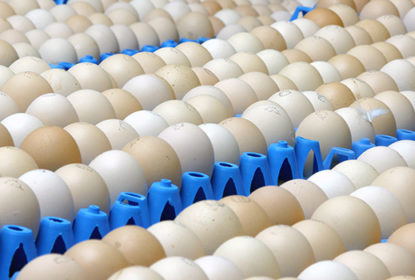
Diagnostics, Global TOP NEWS, Hatchery, Interviews, News, PHT GLOBAL, PHT US, Podcast, Respiratory, TOP NEWS, Videos
... Early infectious bronchitis virus infection causes more severe false layer syndrome
Dec 22, 2021Jennifer GrullonComments Off on Early infectious bronchitis virus infection causes more severe false layer syndrome
Exposure to IBV has been linked with cases of false-layer syndrome, where large cysts in the oviduct prevent birds from laying eggs.... Keeping up with coccidiosis remains challenging
Dec 21, 2021Jennifer GrullonComments Off on Keeping up with coccidiosis remains challenging
By Philip A. Stayer, DVM, ACPV, Corporate Veterinarian, Sanderson Farms, Inc.... Tackling a botulism outbreak in a breeder flock
Dec 16, 2021Jennifer GrullonComments Off on Tackling a botulism outbreak in a breeder flock
Botulism might not be a common occurrence in poultry production, but when it infects a flock, mortalities can be high. That was the situation Sara Throne, DVM, senior director of veterinary services...... Lowering Salmonella load at processing requires company-wide effort initiated from the top
Dec 08, 2021Jennifer GrullonComments Off on Lowering Salmonella load at processing requires company-wide effort initiated from the top
Lowering the load of Salmonella going into the processing plant requires a company-wide effort initiated from the top, panelists advised at a roundtable on food safety.
Global TOP NEWS, Hatchery, Interviews, News, PHT GLOBAL, PHT US, Podcast, Respiratory, TOP NEWS, Videos
... Essential adjustments that improve IB vaccine efficacy in broilers
Dec 05, 2021Jennifer GrullonComments Off on Essential adjustments that improve IB vaccine efficacy in broilers
A few essential adjustments in the way infectious bronchitis vaccines are handled and administered at the hatchery can improve vaccine efficacy.... Ionophore status change would threaten bird health, sustainability, veterinarian warns
Dec 02, 2021Jennifer GrullonComments Off on Ionophore status change would threaten bird health, sustainability, veterinarian warns
There is no need to recategorize ionophores, used as feed additives against coccidiosis, as veterinary medicines, says UK poultry veterinarian Daniel Parker — and doing so could have severe...... Going with the flow: How to maximize the effectiveness of spray vaccination
Nov 10, 2021Jennifer GrullonComments Off on Going with the flow: How to maximize the effectiveness of spray vaccination
Attention to detail is vital when it comes to ensuring that spray vaccinations against respiratory diseases such as infectious bronchitis are as effective as they can possibly be, according to...... Measuring temperature of birds’ faces could help identify heat stress in flocks
Nov 08, 2021Jennifer GrullonComments Off on Measuring temperature of birds’ faces could help identify heat stress in flocks
Use of thermal imaging cameras to measure facial temperatures may offer a non-invasive option for assessing heat stress in commercial broilers, according to research from the University of Arkansas.... Targeted adjuvants may improve recombinant ILT vaccination immune response
Nov 02, 2021Jennifer GrullonComments Off on Targeted adjuvants may improve recombinant ILT vaccination immune response
Vaccination might be effective in controlling ILT in broilers, but recombinant vaccines might not always provide an adequate immune response, according to scientists at North Caroline State...... Study questioning purity of avian reovirus samples has lab and field implications
Nov 01, 2021Jennifer GrullonComments Off on Study questioning purity of avian reovirus samples has lab and field implications
Selecting pure avian reovirus (ARV) cultures is extremely important in pathogenicity and antigenicity studies, as well as in the creation of autogenous vaccines. But in reality, many samples don’t...... Shift to cage-free egg production prompts need to revise health and management plans
Oct 28, 2021Jennifer GrullonComments Off on Shift to cage-free egg production prompts need to revise health and management plans
Vaccinations and other preventative health measures are more critical than ever as the US egg industry shifts toward cage-free and no-antibiotics-ever production.... Tips for uncovering toxicity in poultry flocks
Oct 12, 2021Jennifer GrullonComments Off on Tips for uncovering toxicity in poultry flocks
Toxicity is a relatively rare affliction for hens, and tracking down the source can prove challenging, as one case study outlined by a poultry diagnostics expert revealed.... IBDV linked to severe necrotic enteritis in broiler chickens
Oct 10, 2021Jennifer GrullonComments Off on IBDV linked to severe necrotic enteritis in broiler chickens
Broiler chickens exposed to infectious bursal disease virus are likely to develop more severe cases of the bacterial disease, necrotic enteritis, researchers in Canada have found.... Early IBV infections in layers can increase cysts associated with false layer syndrome
Oct 05, 2021Jennifer GrullonComments Off on Early IBV infections in layers can increase cysts associated with false layer syndrome
The timing of infectious bronchitis virus (IBV) challenge in layers can impact the development of cysts associated with false layer syndrome, scientists at the University of Georgia have discovered.... Direct-fed microbials can impact Salmonella vaccine efficacy
Sep 22, 2021Jennifer GrullonComments Off on Direct-fed microbials can impact Salmonella vaccine efficacy
Some direct-fed microbial additives with live cultures have been found to impact the efficacy of modified-live vaccines.... Pullet vaccination: There’s always room for improvement
Sep 20, 2021Jennifer GrullonComments Off on Pullet vaccination: There’s always room for improvement
TOOLBOX, Issue 17: An interview with Tim Cummings, DVM, Senior Technical Services Veterinarian, Zoetis... IBD control in egg layers has unique challenges
Sep 20, 2021Jennifer GrullonComments Off on IBD control in egg layers has unique challenges
By Daral J. Jackwood, PhD, Professor, The Ohio State University... Feed additive appears to benefit gut integrity in broilers with coccidiosis
Sep 16, 2021Jennifer GrullonComments Off on Feed additive appears to benefit gut integrity in broilers with coccidiosis
The feed additive sodium bisulfate administered to broilers during a coccidial challenge appeared to benefit gut integrity.... Hatchery tips for successful transition to NAE production
Sep 16, 2021Jennifer GrullonComments Off on Hatchery tips for successful transition to NAE production
Preventing birds from getting sick is perhaps the biggest challenge encountered when transitioning from conventional to “no antibiotics ever” (NAE) production.
Diagnostics, Global TOP NEWS, Interviews, News, PHT GLOBAL, PHT US, Podcast, Respiratory, TOP NEWS, Videos, Zoetis News Center
... Periodic IBV PCR testing is key to ensuring vaccination efficacy
Sep 09, 2021Jennifer GrullonComments Off on Periodic IBV PCR testing is key to ensuring vaccination efficacy
Complexes should regularly evaluate the infectious bronchitis viruses (IBV) prevalent on their farms to help determine which vaccines can provide the best protection possible.... Free food safety booklet showcases poultry industry ideas for tackling Salmonella
Sep 09, 2021Jennifer GrullonComments Off on Free food safety booklet showcases poultry industry ideas for tackling Salmonella
Reducing the prevalence of foodborne Salmonella is essential if poultry companies are to improve food safety and pass muster with USDA’s Food Safety and Inspection Service performance standards.
Diagnostics, Global TOP NEWS, Infectious Diseases, Interviews, News, PHT GLOBAL, PHT US, Podcast, TOP NEWS, Videos
... Molecular test helps identify pathogenicity in new strains of infectious bursal disease virus
Sep 03, 2021Jennifer GrullonComments Off on Molecular test helps identify pathogenicity in new strains of infectious bursal disease virus
A genetic technique which could help improve predictions about the virulence of infectious bursal disease (IBDV) has identified pathogenicity in seven new strains of the virus which causes an...... Reaction of poultry company customers to FSIS performance standards varied
Aug 26, 2021Jennifer GrullonComments Off on Reaction of poultry company customers to FSIS performance standards varied
Publication of USDA performance standards prompted some poultry company customers to refuse product from processing plants in Category 3, according to participants at a food safety roundtable.... False layer syndrome in Canada due to DMV/1639
Aug 15, 2021Jennifer GrullonComments Off on False layer syndrome in Canada due to DMV/1639
False layer syndrome due to the Delmarva 1639 (DMV/1639) variant of the infectious bronchitis virus (IBV) is leading to huge economic losses in the Canadian egg industry.... Salmonella control in hatchery, second processing require special attention
Aug 09, 2021Jennifer GrullonComments Off on Salmonella control in hatchery, second processing require special attention
Interventions for Salmonella control throughout the production process are essential, but special attention at the hatchery and during second processing at the plant are critical to success,...
Global TOP NEWS, Infectious Diseases, Interviews, News, PHT GLOBAL, PHT US, Respiratory, TOP NEWS, Videos
... Three keys to successful IBV control
Aug 09, 2021Jennifer GrullonComments Off on Three keys to successful IBV control
Highly contagious and constantly evolving, infectious bronchitis virus (IBV) is notoriously difficult to control.... 5 ways research aims to tackle poultry-sector challenges
Aug 04, 2021Jennifer GrullonComments Off on 5 ways research aims to tackle poultry-sector challenges
Novel, science-based technologies will allow the poultry industry to get ahead of issues coming towards it.... Hatcheries in NAE production systems can’t cut corners on cleaning, husbandry
Aug 04, 2021Jennifer GrullonComments Off on Hatcheries in NAE production systems can’t cut corners on cleaning, husbandry
Hatcheries providing chicks for no antibiotics ever (NAE) production need to be meticulous with cleanliness and good husbandry practices in order for the program to succeed.
Global TOP NEWS, Infectious Diseases, Interviews, News, PHT GLOBAL, PHT US, Podcast, Respiratory, TOP NEWS, Videos
... Two years of IBV sampling underlines importance of surveillance work
Aug 03, 2021Jennifer GrullonComments Off on Two years of IBV sampling underlines importance of surveillance work
Large-scale collection of samples from producers across the southern US is helping shed new light on infectious bronchitis virus (IBV) in chicken flocks — including uncovering a new serotype of the...... Making sense of broiler-feed withdrawal — with the help of a few aphorisms
Aug 01, 2021Jennifer GrullonComments Off on Making sense of broiler-feed withdrawal — with the help of a few aphorisms
By Douglas L. Fulnechek, DVM Senior Public Health Veterinarian Zoetis... Gut microbiota changes linked to E. coli vaccination may support gut health, broiler immune response
Jul 22, 2021Jennifer GrullonComments Off on Gut microbiota changes linked to E. coli vaccination may support gut health, broiler immune response
DISCOVERIES, Issue 13: A recent study found that administering a live Escherichia coli vaccine by spray produced marked, consistent changes in the intestinal microbiota of broilers.... Study: Larger particles in starter feed lead to better performance
Jul 08, 2021Jennifer GrullonComments Off on Study: Larger particles in starter feed lead to better performance
Starter feed of larger particles consumed by young chicks is associated with better performance during the lifetime of broiler birds, according to a study conducted at Mississippi State University.... Seasonal management in hatchery critical to improving chick viability
Jul 07, 2021Jennifer GrullonComments Off on Seasonal management in hatchery critical to improving chick viability
Optimizing hatchery conditions throughout the year is crucial to limiting chick mortality and maintaining long-term bird viability, according to a poultry health expert.... Special Report: Reducing Salmonella, ensuring food safety in poultry production
Jul 06, 2021Jennifer GrullonComments Off on Special Report: Reducing Salmonella, ensuring food safety in poultry production
In a new Special Report, Poultry Health Today taps the industry pulse on the latest efforts to minimize risks in live production and processing, with expert insight on the present and future of...
Antibiotic-free, Biosecurity, Food Safety, Global TOP NEWS, Interviews, News, PHT GLOBAL, PHT US, Podcast, Research, TOP NEWS, Videos
... Better management, biosecurity could mean lower Salmonella levels in NAE farms
Jul 03, 2021Jennifer GrullonComments Off on Better management, biosecurity could mean lower Salmonella levels in NAE farms
New research has suggested that Salmonella levels in no-antibiotics-ever (NAE) poultry systems could be lower than those on conventional broiler farms.... Litter problems persist
Jul 01, 2021Jennifer GrullonComments Off on Litter problems persist
By Tom Tabler, PhD, Extension Professor, Mississippi State University Extension Service, Poultry Science Department, Mississippi State, MS
Biosecurity, Food Safety, Global TOP NEWS, Interviews, News, PHT GLOBAL, PHT US, Podcast, TOP NEWS, Videos
... Litter management can help control Salmonella Heidelberg
Jun 28, 2021Jennifer GrullonComments Off on Litter management can help control Salmonella Heidelberg
Ongoing studies to find ways of managing Salmonella Heidelberg loads in poultry litter have suggested that downtime is key to reducing the pathogen’s rates.... Lessons from the Midwest’s 2015 avian flu outbreak
Jun 24, 2021Jennifer GrullonComments Off on Lessons from the Midwest’s 2015 avian flu outbreak
The 2015 outbreak of highly pathogenic avian influenza (HPAI) in Minnesota was the worst the US has ever seen. What has the poultry industry learned from this and other outbreaks?
Food Safety, Global TOP NEWS, Gut Health, Interviews, News, PHT GLOBAL, PHT US, Podcast, Sustainability, TOP NEWS, Videos
... Right skills critical to managing increases in Salmonella, coccidiosis associated with cage-free egg production
Jun 23, 2021Jennifer GrullonComments Off on Right skills critical to managing increases in Salmonella, coccidiosis associated with cage-free egg production
Producers making the switch to cage-free egg production need to ensure they are properly prepared for managing potential increases in Salmonella and other health challenges.
Diagnostics, Global TOP NEWS, Infectious Diseases, Interviews, News, PHT GLOBAL, PHT US, TOP NEWS, Videos
... Diagnostics key to effective mycoplasma control
Jun 20, 2021Jennifer GrullonComments Off on Diagnostics key to effective mycoplasma control
Avian mycoplasmosis is a problem for poultry producers worldwide, but according to an expert, there’s no “one-size-fits-all” approach to managing it.... Population diagnostics challenging for poultry veterinarians
Jun 14, 2021Jennifer GrullonComments Off on Population diagnostics challenging for poultry veterinarians
By Philip A. Stayer, DVM, MS, ACPV, Corporate Veterinarian, Sanderson Farms, Inc.... 5 steps to preventing heat stress in layers
Jun 14, 2021Jennifer GrullonComments Off on 5 steps to preventing heat stress in layers
By John Brown, DVM, Senior Technical Services Veterinarian Zoetis... Poultry companies using variety of interventions to improve food safety
Jun 09, 2021Jennifer GrullonComments Off on Poultry companies using variety of interventions to improve food safety
Poultry companies are using a variety of interventions to curb Salmonella and improve food safety, even though it’s not always easy to justify the cost of each, panelists said at a food-safety...... Temperature and air flow critical to broiler performance year-round
Jun 07, 2021Jennifer GrullonComments Off on Temperature and air flow critical to broiler performance year-round
By Michael Czarick, Engineering Specialist, University of Georgia Department of Poultry Science... Control key to protecting flocks from more virulent, resistant E. coli
Jun 03, 2021Jennifer GrullonComments Off on Control key to protecting flocks from more virulent, resistant E. coli
Research shows many strains of E. coli are capable of causing disease directly. And with antibiotic resistance on the rise, control and prevention are essential.... Management of birds and environment reduce industry’s carbon footprint
Jun 02, 2021Jennifer GrullonComments Off on Management of birds and environment reduce industry’s carbon footprint
Pressure to reduce poultry production’s carbon footprint presents multiple hurdles, but the industry is up to the challenge, said Joseph Giambrone, PhD, professor, Auburn University.... Tackling stress key to protecting birds from coryza resurgence, says expert
Jun 02, 2021Jennifer GrullonComments Off on Tackling stress key to protecting birds from coryza resurgence, says expert
Limiting stress in broiler flocks is key to preventing birds from succumbing to an infectious respiratory disease which is showing a resurgence in some areas of the US, according to a poultry expert.... Good management and biosecurity vital to overcoming disease challenges in NAE systems
Jun 02, 2021Jennifer GrullonComments Off on Good management and biosecurity vital to overcoming disease challenges in NAE systems
Getting back to basics with bird and house management is key to overcoming coccidiosis and other health issues affecting producers using NAE systems.... Infectious bronchitis DMV 1639: More questions than answers
Jun 01, 2021Jennifer GrullonComments Off on Infectious bronchitis DMV 1639: More questions than answers
By Philip A. Stayer, DVM, MS, ACPV, Corporate Veterinarian, Sanderson Farms, Inc.... Marek’s disease vaccination needed now more than ever
May 25, 2021Jennifer GrullonComments Off on Marek’s disease vaccination needed now more than ever
By Guillermo Zavala, DVM, MAM, MSc, PhD, Dipl. ACPV Adjunct Professor, University of Georgia President, Avian Health International, LLC Flowery Branch, Georgia (USA)
Biosecurity, Diagnostics, Food Safety, Global TOP NEWS, Interviews, News, PHT GLOBAL, PHT US, Podcast, TOP NEWS, Videos
... Utilizing on-farm testing key to helping processors understand S. Infantis loads
May 25, 2021Jennifer GrullonComments Off on Utilizing on-farm testing key to helping processors understand S. Infantis loads
Using a range of testing methods for Salmonella Infantis can help broiler companies build a better picture of how effective interventions against the pathogen are performing.... E. coli vaccination in broilers: Is it worth the cost?
May 15, 2021Jennifer GrullonComments Off on E. coli vaccination in broilers: Is it worth the cost?
According to recent studies, E. coli vaccination may actually help broiler producers boost their bottom lines.... Calcium toxicity cases underscore value of networking for knowledge
May 15, 2021Jennifer GrullonComments Off on Calcium toxicity cases underscore value of networking for knowledge
By Philip A. Stayer, DVM, MS, ACPV, Corporate Veterinarian, Sanderson Farms, Inc.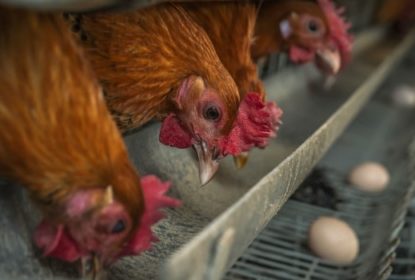
Global TOP NEWS, Infectious Diseases, Interviews, News, PHT GLOBAL, PHT US, Podcast, Research, TOP NEWS, Videos
... False layer syndrome linked to early infectious bronchitis exposure
May 14, 2021Jennifer GrullonComments Off on False layer syndrome linked to early infectious bronchitis exposure
Research is increasingly linking false layer syndrome to early exposure to infectious bronchitis virus. The condition prevents laying hens from producing eggs, but birds display few outward signs of...... Cross-protection vaccine protocols key to limiting DMV/1639 spread in US flocks
May 04, 2021Jennifer GrullonComments Off on Cross-protection vaccine protocols key to limiting DMV/1639 spread in US flocks
Combining serotype vaccines might be a popular approach to protecting flocks against evolving strains of infectious bronchitis virus, such as DMV/1639, but not all combinations work equally well.... Testing mixed control approaches important in controlling Salmonella in broilers
Apr 26, 2021Jennifer GrullonComments Off on Testing mixed control approaches important in controlling Salmonella in broilers
Commercial broiler farms often employ a multi-faceted approach in tackling Salmonella, but testing different combinations of control options together on a small scale before they are rolled out...... Pathways to protection: How one vaccine decision can affect options for managing other diseases in broilers
Apr 22, 2021Jennifer GrullonComments Off on Pathways to protection: How one vaccine decision can affect options for managing other diseases in broilers
Broiler operations want to provide the best disease protection for the least cost, but deciding which vaccines to use and when can be a daunting task.... Hatchery details key to maximizing chick performance, expert says
Apr 01, 2021Jennifer GrullonComments Off on Hatchery details key to maximizing chick performance, expert says
A back-to-basics approach toward managing, handling and storing eggs can help maximize the quality and hatchability of chicks being produced for broiler flocks, according to an industry expert.... Incubation key to preventing leg problems in turkey poults
Mar 31, 2021Jennifer GrullonComments Off on Incubation key to preventing leg problems in turkey poults
Managing heat and humidity in hatcheries is key to reducing costly leg problems in turkey poults.... New vaccine simplifies IBDV vaccination; provides effective early pullet protection
Mar 18, 2021Jennifer GrullonComments Off on New vaccine simplifies IBDV vaccination; provides effective early pullet protection
TOOLBOX, Issue 25: An interview with John Brown, DVM, senior technical services veterinarian and layer specialist, Zoetis on early pullet protection from IBDV.... Good gut health starts before hatch, expert says
Mar 12, 2021Jennifer GrullonComments Off on Good gut health starts before hatch, expert says
To establish good gut health, measures to promote a healthy microbiome can’t begin soon enough, an expert reports.... Histopathology helping poultry plants use science to defend carcasses, minimize condemnations
Feb 24, 2021Jennifer GrullonComments Off on Histopathology helping poultry plants use science to defend carcasses, minimize condemnations
Veterinarians specializing in diagnosing disease in animal tissue are spending more time in processing plants helping minimize costly carcass condemnations while maintaining high food quality...... Latest breeder, broiler vaccines provide consistent IBDV immunity
Feb 09, 2021Jennifer GrullonComments Off on Latest breeder, broiler vaccines provide consistent IBDV immunity
TOOLBOX, Issue 23: An interview with Kalen Cookson, DVM, MAM, Director of Clinical Research, Zoetis about Poulvac Maternavac 4 and Poulvac Procerta HVT-IBD.... SPECIAL REPORT: Don’t let immunosuppressive diseases compromise broiler performance
Feb 02, 2021Jennifer GrullonComments Off on SPECIAL REPORT: Don’t let immunosuppressive diseases compromise broiler performance
Immunosuppressive diseases such as IBDV, Marek's and reovirus can compromise a bird's ability to fight off secondary infections. Keeping them in check becomes even more critical as poultry companies...... SPECIAL REPORT, Day 2: News reports and interviews from IPSF
Jan 26, 2021Jennifer GrullonComments Off on SPECIAL REPORT, Day 2: News reports and interviews from IPSF
The 2021 virtual International Poultry Scientific Forum (IPSF) meeting is underway. Our editors are covering sessions and capturing interviews for future posts. Here's a look back at our 2020...... SPECIAL REPORT, Day 1: News reports and interviews from IPSF
Jan 25, 2021Jennifer GrullonComments Off on SPECIAL REPORT, Day 1: News reports and interviews from IPSF
The 2021 virtual International Poultry Scientific Forum (IPSF) meeting is underway. Our editors are covering sessions and capturing interviews for future posts. Here's a look back at our 2020...... Robust challenge studies demonstrate efficacy of new recombinant vector vaccine for IBDVs
Jan 21, 2021Jennifer GrullonComments Off on Robust challenge studies demonstrate efficacy of new recombinant vector vaccine for IBDVs
DISCOVERIES, Issue 12: A new recombinant vector vaccine provides early protection against variant, classic and very virulent infectious bursal disease viruses, robust challenge studies demonstrate.... QX, 793b found to be most prevalent IBV field strains in Europe
Dec 22, 2020Jennifer GrullonComments Off on QX, 793b found to be most prevalent IBV field strains in Europe
DISCOVERIES, Issue 11: Two recent studies assessed the prevalence of various IBV strains in Europe in recent years, with QX and 793b proving the most common causes of virulent disease in chickens.... Serotype, presentation of IBH differ in large and small birds
Dec 18, 2020Jennifer GrullonComments Off on Serotype, presentation of IBH differ in large and small birds
More than one serotype has been the cause of inclusion body hepatitis (IBH) in broilers, which has presented differently in large- and small-bird complexes.... Good gut health can help minimize Salmonella in broilers
Dec 17, 2020Jennifer GrullonComments Off on Good gut health can help minimize Salmonella in broilers
TOOLBOX, Issue 14: An interview with Manuel Da Costa, DVM, PhD, Associate Director, Outcomes Research, Zoetis... Coccidiosis in conventional flocks presenting a significant challenge
Dec 07, 2020Jennifer GrullonComments Off on Coccidiosis in conventional flocks presenting a significant challenge
A shift in microbiology could be responsible for a surge in coccidiosis problems being seen in conventional US broiler and pullets flocks, according to Pilgrim's DVM Suzanne Dougherty.... Z-CAS helping feed mills, producers get the most from medicated feed additives
Nov 30, 2020Jennifer GrullonComments Off on Z-CAS helping feed mills, producers get the most from medicated feed additives
TOOLBOX, Issue 6: An interview with Marc Howerton, Customer Analytical Services Supervisor, Zoetis... Now more than ever, vaccination is critical for managing Salmonella in layer flocks
Nov 28, 2020Jennifer GrullonComments Off on Now more than ever, vaccination is critical for managing Salmonella in layer flocks
TOOLBOX, Issue 22: An interview with Kalen Cookson, DVM, MAM, Director of Clinical Research, Zoetis... S. Heidelberg load reduced in chicks treated with acidified water the first 2 weeks of life
Nov 19, 2020Jennifer GrullonComments Off on S. Heidelberg load reduced in chicks treated with acidified water the first 2 weeks of life
DISCOVERIES, Issue 9: Chicks that received acidified water for the first 2 weeks of life had a significantly reduced load of Salmonella Heidelberg, a challenge study demonstrates.... NCSU: Enterococcus co-infection makes colibacillosis deadlier in poultry
Nov 12, 2020Jennifer GrullonComments Off on NCSU: Enterococcus co-infection makes colibacillosis deadlier in poultry
Researchers from North Carolina State University have found that when a particular strain of Enterococcus is found alongside E. coli in cases of avian colibacillosis, there is a higher rate of...
Flock welfare, Global TOP NEWS, Infectious Diseases, Interviews, News, PHT GLOBAL, PHT US, Podcast, Research, TOP NEWS, Videos
... Consider predominance of AL-2 variants when planning IBDV vaccination program
Nov 09, 2020Jennifer GrullonComments Off on Consider predominance of AL-2 variants when planning IBDV vaccination program
The AL-2 family of variants is the predominant strain of infectious bursal disease virus (IBDV) circulating among US broiler flocks, according to a recent survey.... Poulvac® Procerta™ HVT-ND provides advantages of a recombinant plus 19-day onset of immunity
Nov 02, 2020Jennifer GrullonComments Off on Poulvac® Procerta™ HVT-ND provides advantages of a recombinant plus 19-day onset of immunity
Poulvac®️ Procerta™️ HVT-ND provides producers with all the advantages of a recombinant vectored vaccine while protecting chickens against Newcastle and Marek’s diseases as early as 19 days...
Antibiotic-free, Global TOP NEWS, Gut Health, Interviews, News, PHT GLOBAL, PHT US, Podcast, Research, TOP NEWS, Videos
... Glutamine supplement shows promise in reducing necrotic enteritis
Oct 26, 2020Jennifer GrullonComments Off on Glutamine supplement shows promise in reducing necrotic enteritis
Supplementing poultry diets with glutamine could help reduce the severity of necrotic enteritis (NE), according to researchers.... Studies in 32 million birds show returns on vaccinating broilers for E. coli
Oct 22, 2020Jennifer GrullonComments Off on Studies in 32 million birds show returns on vaccinating broilers for E. coli
DISCOVERIES, Issue 8: In studies conducted in more than 32 million broiler chickens in Italy and the US, vaccination with Poulvac® E. coli yielded a positive return on investment.... Researchers decode clues to Salmonella Infantis control
Oct 05, 2020Jennifer GrullonComments Off on Researchers decode clues to Salmonella Infantis control
New research from Austria provides key regional insights into Salmonella Infantis, a foodborne pathogen that is closely linked with broiler farms and often resistant to antibiotics.... New four-way broiler breeder vaccine builds on success of Maternavac name
Sep 24, 2020Jennifer GrullonComments Off on New four-way broiler breeder vaccine builds on success of Maternavac name
TOOLBOX, Issue 20: An interview with Kalen Cookson, DVM, MAM, Director of Clinical Research, Zoetis... Sleuthing to pinpoint source of commercial flock pathogens
Sep 17, 2020Jennifer GrullonComments Off on Sleuthing to pinpoint source of commercial flock pathogens
By Philip A. Stayer, DVM, MS, ACPV, Corporate Veterinarian, Sanderson Farms, Inc.... Free booklet recaps highlights of infectious bronchitis roundtable
Sep 10, 2020Jennifer GrullonComments Off on Free booklet recaps highlights of infectious bronchitis roundtable
A colorful 28-page booklet recapping highlights of a roundtable discussion on infectious bronchitis virus is now available. The event featured experts and practitioners who shared their practical...... Treatment blend offers ‘exciting potential’ for Campylobacter control at processing
Sep 03, 2020Jennifer GrullonComments Off on Treatment blend offers ‘exciting potential’ for Campylobacter control at processing
Blending two commonly used antibacterial treatments could help processing facilities take better control of Campylobacter and reduce the risk of food-borne illnesses, according to scientists.... Veterinarian: Rethink layer health programs with move to cage-free
Sep 02, 2020Jennifer GrullonComments Off on Veterinarian: Rethink layer health programs with move to cage-free
The poultry industry’s gradual switch to cage-free egg production has underscored the need to rethink disease-control programs.... Managing the health challenges of moving to free-range egg production
Aug 31, 2020Jennifer GrullonComments Off on Managing the health challenges of moving to free-range egg production
Free-range egg production will bring major challenges to the way birds are produced, but it will also mean big shifts in the ways bird health and welfare need to be managed.... Training and management critical for cage-free egg production
Aug 27, 2020Jennifer GrullonComments Off on Training and management critical for cage-free egg production
Training chicks and pullets so they are prepared for life in cage-free egg systems is critical to ensuring they meet their full productive potential.... State-of-the-art recombinant Poulvac® Procerta™ HVT-ND protects against Newcastle and Marek’s diseases
Aug 24, 2020Jennifer GrullonComments Off on State-of-the-art recombinant Poulvac® Procerta™ HVT-ND protects against Newcastle and Marek’s diseases
TOOLBOX, Issue 19: An interview with Abigail Reith, DVM, MAM, DACPV, Technical Services Veterinarian, Zoetis
Antibiotic-free, Global TOP NEWS, Hatchery, Interviews, News, PHT GLOBAL, PHT US, Podcast, TOP NEWS, Videos
... Chick quality vital to no-antibiotics-ever success, consultant says
Aug 20, 2020Jennifer GrullonComments Off on Chick quality vital to no-antibiotics-ever success, consultant says
Focusing on chick quality from the moment eggs enter the incubator is critical to ensuring birds have the best chance of being healthy and productive in no-antibiotics-ever (NAE) systems.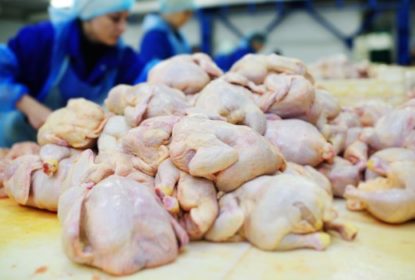
Condemnations, Food Safety, Global TOPICS, Interviews, News, PHT GLOBAL, PHT US, Podcast, TOPICS, Videos
... New avian leukosis rule expected to reduce waste, improve efficiency for processing plants and FSIS
Aug 13, 2020Jennifer GrullonComments Off on New avian leukosis rule expected to reduce waste, improve efficiency for processing plants and FSIS
Acceptance of a petition designating avian leukosis lesions on poultry carcasses as a trimmable condition is expected to reduce waste and improve efficiency at processing plants while allowing meat...... NAE production uncovers water quality challenges
Aug 13, 2020Jennifer GrullonComments Off on NAE production uncovers water quality challenges
By Tom Tabler, PhD, Extension Professor, Mississippi State University Extension Service, Poultry Science Department, Mississippi State, Mississippi... Intestinal health in the era of NAE
Aug 13, 2020Jennifer GrullonComments Off on Intestinal health in the era of NAE
By Tom Tabler, PhD, Extension Professor, Mississippi State University Extension Service, Poultry Science Department, Mississippi State, Mississippi... Check equipment now to help birds withstand summer heat
Aug 12, 2020Jennifer GrullonComments Off on Check equipment now to help birds withstand summer heat
By Jess Campbell, Jeremiah Davis and Kelly Griggs, National Poultry Technology Center, Auburn University... Antibiotics and the poultry industry: What’s next?
Aug 12, 2020Jennifer GrullonComments Off on Antibiotics and the poultry industry: What’s next?
Nearly 6 in 10 broiler chickens in the US are now raised without antibiotics. Is this all-or-nothing strategy necessarily a good trend? And what precautions need to be taken?... Tailoring control measures key to managing Salmonella
Aug 10, 2020Jennifer GrullonComments Off on Tailoring control measures key to managing Salmonella
Producers need to take more care in matching Salmonella vaccines for broiler breeders to the strain of the pathogen challenging their flocks.... SPECIAL REPORT, Day 3: News reports and interviews from AAAP
Aug 04, 2020Jennifer GrullonComments Off on SPECIAL REPORT, Day 3: News reports and interviews from AAAP
Day 3 of the 2020 American Association of Avian Pathologists' virtual conference is under way. Our editors are capturing interviews for future posts. Here's a look back at our 2019 coverage.... SPECIAL REPORT, Day 2: News reports and interviews from AAAP
Aug 03, 2020Jennifer GrullonComments Off on SPECIAL REPORT, Day 2: News reports and interviews from AAAP
Day 2 of the 2020 American Association of Avian Pathologists' virtual conference is under way. Our editors are capturing interviews for future posts. Here's a look back at our 2019 coverage.... SPECIAL REPORT, Day 1: News reports and interviews from AAAP
Aug 02, 2020Jennifer GrullonComments Off on SPECIAL REPORT, Day 1: News reports and interviews from AAAP
Day 1 of the 2020 American Association of Avian Pathologists' virtual conference is under way. Our editors are capturing interviews for future posts. Here's a look back at our 2019 coverage.... New Poulvac Maternavac® 4 vaccine formulated to address contemporary field challenge
Jul 23, 2020Jennifer GrullonComments Off on New Poulvac Maternavac® 4 vaccine formulated to address contemporary field challenge
DISCOVERIES, Issue 6: The rapid growth in reduced and “no antibiotics ever” production was the driving force behind development of a new vaccine to protect chickens against four costly diseases.... Live Salmonella vaccines, some DFMs may not mix
Jul 20, 2020Jennifer GrullonComments Off on Live Salmonella vaccines, some DFMs may not mix
By Philip A. Stayer, DVM, MS, ACPV, Corporate Veterinarian, Sanderson Farms, Inc.
Flock welfare, Global TOPICS, Infectious Diseases, Interviews, News, PHT GLOBAL, PHT US, Podcast, TOPICS, Videos
... ND is stable in US but poultry industry should be on lookout for evolving strains
Jul 13, 2020Jennifer GrullonComments Off on ND is stable in US but poultry industry should be on lookout for evolving strains
Newcastle disease throughout most of the US remains stable, but the industry needs to be on guard for changes in the virus that may require adaption of ND vaccines.... Vaccination with Poulvac® E. coli yields economic benefits in broilers
Jul 07, 2020Jennifer GrullonComments Off on Vaccination with Poulvac® E. coli yields economic benefits in broilers
DISCOVERIES, Issue 7: Vaccinating broilers against Escherichia coli yielded a favorable return on investment in a recent trial... Surveillance of circulating IBV types essential for disease control
Jul 06, 2020Jennifer GrullonComments Off on Surveillance of circulating IBV types essential for disease control
Surveillance aimed at pinpointing the type of infectious bronchitis virus that’s circulating in poultry flocks is essential to control of the disease.... USDA urged to give producers time to trial Campylobacter and Salmonella interventions
Jun 28, 2020Jennifer GrullonComments Off on USDA urged to give producers time to trial Campylobacter and Salmonella interventions
Greater flexibility is needed in official Salmonella and Campylobacter testing regimes in order to support poultry producers and processors who are trialing new interventions to tackle both... Stress is nothing to mess with, folks: 5 steps for connecting with each other in troubled times
Jun 23, 2020Jennifer GrullonComments Off on Stress is nothing to mess with, folks: 5 steps for connecting with each other in troubled times
By Tom Tabler, PhD Extension Professor Mississippi State University Extension Service, Poultry Science Department Mississippi State, MS... Poulvac® Procerta™ HVT-ND fully protects against Newcastle disease by 19 days of age
Jun 18, 2020Jennifer GrullonComments Off on Poulvac® Procerta™ HVT-ND fully protects against Newcastle disease by 19 days of age
DISCOVERIES, Issue 5: Rigorous research and the application of cutting-edge technology by Zoetis scientists were behind the development of the newest recombinant vaccine to protect broilers from ...... NAE production: Helping contract growers navigate maze of new challenges
Jun 11, 2020Jennifer GrullonComments Off on NAE production: Helping contract growers navigate maze of new challenges
By Tom Tabler, PhD, Extension Professor, Mississippi State University Extension Service, Poultry Science Department Mississippi State, Mississippi... Study: Live S. Typhimurium vaccine reduces S. Infantis colonization
Jun 10, 2020Jennifer GrullonComments Off on Study: Live S. Typhimurium vaccine reduces S. Infantis colonization
Investing in vaccination programs to develop cross-protection against some of the most common strains of Salmonella could help limit the number of foodborne outbreaks of the pathogen.... Mountaire Farms is first company to carry the One Health Certified label
Jun 04, 2020Jennifer GrullonComments Off on Mountaire Farms is first company to carry the One Health Certified label
Mountaire Farms is the first animal protein company to carry the One Health Certified label, demonstrating its commitment to animal production standards established by the program.... Poultry biosecurity has lessons for coping with COVID-19
Jun 01, 2020Jennifer GrullonComments Off on Poultry biosecurity has lessons for coping with COVID-19
By Tom Tabler, PhD, Extension Professor, Mississippi State University Extension Service, Poultry Science Department, Mississippi State, Mississippi... Moving animal health to the back burner — if only for a moment
May 21, 2020Jennifer GrullonComments Off on Moving animal health to the back burner — if only for a moment
By Larry Rueff, DVM, Swine Vet Services, Greensburg, Indiana... CDC report urges more vaccination against Salmonella
May 13, 2020Jennifer GrullonComments Off on CDC report urges more vaccination against Salmonella
The CDC has urged more vaccination to control Salmonella in poultry flocks after latest figures revealed illnesses linked to certain strains of the pathogen were stalling or in decline.... Prepare now for summer heat, humidity
May 05, 2020Jennifer GrullonComments Off on Prepare now for summer heat, humidity
By Tom Tabler, PhD, Extension Professor, Mississippi State University Extension Service, Poultry Science Department, Mississippi State, Mississippi... Nearly 60% of US broilers now raised without antibiotics, but that number may have peaked
May 04, 2020Jennifer GrullonComments Off on Nearly 60% of US broilers now raised without antibiotics, but that number may have peaked
Nearly six in 10 US broilers were raised without antibiotics of any type in 2019 — but that number may have peaked.... Poultry experts cite frustration with infectious bronchitis variants
Apr 30, 2020Jennifer GrullonComments Off on Poultry experts cite frustration with infectious bronchitis variants
New, variant strains of infectious bronchitis virus in poultry will continue to emerge, but their control may depend primarily on strategic vaccination protocols that provide cross-protection from...... Caution: Simple errors can derail IBV vaccine effectiveness
Apr 27, 2020Jennifer GrullonComments Off on Caution: Simple errors can derail IBV vaccine effectiveness
Common pitfalls that can occur while vaccinating broilers against infectious bronchitis virus (IBV) could derail vaccine effectiveness, panelists cautioned during an industry roundtable.... German researchers: Poultry, pigs not susceptible to COVID-19
Apr 15, 2020Jennifer GrullonComments Off on German researchers: Poultry, pigs not susceptible to COVID-19
Scientists in Germany have confirmed that pigs and chickens are not susceptible to COVID-19.... Return of RofenAid® 40 gives turkey industry dependable tool for managing coccidiosis, fowl cholera
Apr 14, 2020Jennifer GrullonComments Off on Return of RofenAid® 40 gives turkey industry dependable tool for managing coccidiosis, fowl cholera
TOOLBOX, Issue 21: An interview with David Rives, DVM, Technical Services Veterinarian, Zoetis... DMV/1639 now the focus of many IBV control programs in US flocks
Apr 13, 2020Jennifer GrullonComments Off on DMV/1639 now the focus of many IBV control programs in US flocks
Variants of infectious bronchitis virus affecting broiler flocks differ regionally, but the strain causing the most concern lately appears to be Delmarva/1639.... Highly pathogenic H7N3 avian influenza confirmed in US commercial turkey flock
Apr 10, 2020Jennifer GrullonComments Off on Highly pathogenic H7N3 avian influenza confirmed in US commercial turkey flock
A commercial turkey flock in South Carolina has tested positive for highly pathogenic H7N3 avian influenza (HPAI).... Foster Farms: Community approach key to managing coryza spread in poultry
Apr 09, 2020Jennifer GrullonComments Off on Foster Farms: Community approach key to managing coryza spread in poultry
Tackling endemic poultry diseases as a community rather than as individual producers can play an important role in controlling and limiting their spread.... Controlling infectious bronchitis in broilers starts with breeder vaccination
Apr 03, 2020Jennifer GrullonComments Off on Controlling infectious bronchitis in broilers starts with breeder vaccination
Protocols vary widely, but vaccinating broiler breeders against infectious bronchitis virus remains an important strategy for protecting broiler progeny against the virus.... Good flock management key to managing Mycoplasma synoviae resurgence
Apr 02, 2020Jennifer GrullonComments Off on Good flock management key to managing Mycoplasma synoviae resurgence
Broiler producers need to take a fresh look at housing conditions and bird management to help counter the resurgence of Mycoplasma synoviae linked to an increase in raised without antibiotics (RWA)...... Measuring effectiveness of on-farm interventions key to Salmonella control
Mar 30, 2020Jennifer GrullonComments Off on Measuring effectiveness of on-farm interventions key to Salmonella control
Understanding the impact specific on-farm interventions can have on Salmonella is critical to helping the US poultry industry meet government standards around the disease, according to a leading...... Prestage Farms veterinarian: Processing chain communication critical to identify health issues early, reduce turkey condemnations
Mar 11, 2020Jennifer GrullonComments Off on Prestage Farms veterinarian: Processing chain communication critical to identify health issues early, reduce turkey condemnations
Developing good relationships across the processing chain can be critical in helping to identify and overcome issues on farm and in the processing plant.... Sanderson vet: Keeping up with variant reovirus strains remains challenging
Mar 06, 2020Jennifer GrullonComments Off on Sanderson vet: Keeping up with variant reovirus strains remains challenging
Poor uniformity, lameness and reduced water consumption are tip-offs that broilers may be infected with variant reovirus.... Swift communication key to limiting the risk of poultry disease outbreaks
Mar 05, 2020Jennifer GrullonComments Off on Swift communication key to limiting the risk of poultry disease outbreaks
Excellent systems of communication between farm staff and veterinarians are critical when it comes to managing disease outbreaks and reducing their potential spread.... Decisions, decisions: Which gut health strategies should be used when?
Feb 17, 2020Jennifer GrullonComments Off on Decisions, decisions: Which gut health strategies should be used when?
As the poultry industry moves to limit antibiotic use, alternative measures to support gut health are now common practice, but more guidance is needed with respect to which strategies to use under...... Failure of maternal antibodies to protect against E. coli infection highlights need for early protection
Feb 13, 2020Jennifer GrullonComments Off on Failure of maternal antibodies to protect against E. coli infection highlights need for early protection
New studies in broiler chicks show that maternal antibodies to Escherichia coli do not prevent infection.... JAVMA report: Newcastle reemerges, spreads in California
Jan 30, 2020Jennifer GrullonComments Off on JAVMA report: Newcastle reemerges, spreads in California
Virulent Newcastle disease resurged in Southern California as people broke quarantines by moving birds and farming equipment, according to a report by JAVMA.... Day 4 SPECIAL REPORT: News reports and interviews from IPPE
Jan 30, 2020Jennifer GrullonComments Off on Day 4 SPECIAL REPORT: News reports and interviews from IPPE
The 2020 International Production & Processing Expo is under way in Atlanta. Our editors are onsite, covering sessions and capturing interviews for future posts. Here's a look back at our 2019...... Day 3 SPECIAL REPORT: News reports and interviews from IPPE
Jan 29, 2020Jennifer GrullonComments Off on Day 3 SPECIAL REPORT: News reports and interviews from IPPE
The 2020 International Production & Processing Expo is under way in Atlanta. Our editors are onsite, covering sessions and capturing interviews for future posts. Here's a look back at our 2019...... Day 2 SPECIAL REPORT: News reports and interviews from IPPE
Jan 28, 2020Jennifer GrullonComments Off on Day 2 SPECIAL REPORT: News reports and interviews from IPPE
The 2020 International Production & Processing Expo is under way in Atlanta. Our editors are onsite, covering sessions and capturing interviews for future posts. Here's a look back at our 2019...... More than 35 poultry-health experts at IPPE to be interviewed on camera by Poultry Health Today
Jan 27, 2020Jennifer GrullonComments Off on More than 35 poultry-health experts at IPPE to be interviewed on camera by Poultry Health Today
More than 35 poultry-health experts and trend watchers will be interviewed on camera over 3 days as part of Poultry Health Today’s news coverage of the 2020 IPPE and IPSF.... Day 1 SPECIAL REPORT: News reports and interviews from IPPE
Jan 27, 2020Jennifer GrullonComments Off on Day 1 SPECIAL REPORT: News reports and interviews from IPPE
The 2020 International Production & Processing Expo is under way in Atlanta. Our editors are onsite, covering sessions and capturing interviews for future posts. Here's a look back at our 2019...... Hospitals offer inspiration for next-generation poultry biosecurity tools
Jan 03, 2020Jennifer GrullonComments Off on Hospitals offer inspiration for next-generation poultry biosecurity tools
Researchers in Canada are looking to human hospitals as inspiration for developing next-generation techniques to improve biosecurity on poultry farms.... ‘Causal’ pie chart can help manage necrotic enteritis
Dec 29, 2019Jennifer GrullonComments Off on ‘Causal’ pie chart can help manage necrotic enteritis
Use of a simple “causal” pie chart is proving to be a helpful tool for controlling necrotic enteritis (NE).... What more can live production do to reduce Salmonella in poultry?
Dec 26, 2019Jennifer GrullonComments Off on What more can live production do to reduce Salmonella in poultry?
Successful Salmonella control throughout live poultry production requires an integrated effort, attention to detail and careful follow-through to help processing plants meet more stringent USDA...... Managing anticoccidials: ‘It’s how you use them that’s important’
Dec 23, 2019Jennifer GrullonComments Off on Managing anticoccidials: ‘It’s how you use them that’s important’
Coccidiosis takes a toll of around $3 billion on global poultry production each year, making it one of the industry’s most economically significant diseases worldwide.... One Health Certified label seeks balanced approach to poultry production, marketing
Dec 23, 2019Jennifer GrullonComments Off on One Health Certified label seeks balanced approach to poultry production, marketing
A new label under development for meat and poultry products will represent production that seeks a balanced approach to poultry production and marketing.... Poultry Health Today launches Zoetis News Center
Dec 18, 2019Jennifer GrullonComments Off on Poultry Health Today launches Zoetis News Center
Poultry Health Today has introduced the Zoetis News Center — a special section of the popular news website that features insights from Zoetis’ poultry health experts, plus updates on...... E. coli vaccination yields bottom-line benefits on South African broiler farms
Dec 10, 2019Jennifer GrullonComments Off on E. coli vaccination yields bottom-line benefits on South African broiler farms
New research from South Africa shows that vaccinating broilers against Escherichia coli is good not just for birds, but also for bottom lines.... Industry needs more poultry scientists to tackle disease challenges
Dec 03, 2019Jennifer GrullonComments Off on Industry needs more poultry scientists to tackle disease challenges
More young people need to be encouraged to take up careers in poultry science if the sector is to properly tackle disease challenges which have plagued it for decades.... Salmonella’s sex life key to mitigating food safety risks
Nov 14, 2019Jennifer GrullonComments Off on Salmonella’s sex life key to mitigating food safety risks
Food safety challenges linked to Salmonella could be tackled more effectively by better understanding the sex life of bacteria, according to a leading US government veterinarian.... Ensuring strong immunity key to successful ‘no antibiotics ever’ broiler production
Nov 01, 2019Jennifer GrullonComments Off on Ensuring strong immunity key to successful ‘no antibiotics ever’ broiler production
Producers raising broilers with no or fewer antibiotics need to pay more attention to diseases that can compromise flock immunity and make birds more susceptible to primary and secondary...... Virulent ND outbreaks underscore need to rethink vaccination program
Nov 01, 2019Jennifer GrullonComments Off on Virulent ND outbreaks underscore need to rethink vaccination program
By Philip A. Stayer, DVM, MS, ACPV, Corporate Veterinarian, Sanderson Farms, Inc.
Global TOP NEWS, Infectious Diseases, Interviews, News, PHT GLOBAL, PHT US, Podcast, TOP NEWS, Videos
... Unusual presentation of bacterial septicemia in broilers tied to breeders
Oct 29, 2019Jennifer GrullonComments Off on Unusual presentation of bacterial septicemia in broilers tied to breeders
An unusual presentation of bacterial septicemia in broilers underscores the importance of obtaining a good history and input from bird caretakers, according to David French, DVM, a staff veterinarian...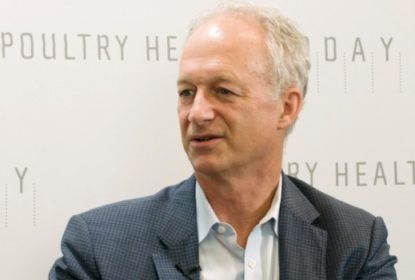
Biosecurity, Food Safety, Global TOPICS, Interviews, News, PHT GLOBAL, PHT US, Podcast, TOPICS, Videos
... Perdue veterinarian seeks answers to inconsistent foodborne pathogen load
Oct 28, 2019Jennifer GrullonComments Off on Perdue veterinarian seeks answers to inconsistent foodborne pathogen load
Taking a closer look at why incidence of Salmonella and Campylobacter varied widely on farms in the same production system helped to demonstrate the importance of management and communication with...... Moisture monitoring critical to improving bird health and welfare
Oct 23, 2019Jennifer GrullonComments Off on Moisture monitoring critical to improving bird health and welfare
Poultry shed humidity should be monitored as regularly as shed temperature and ventilation to ensure bird health and productivity is as high as it can be.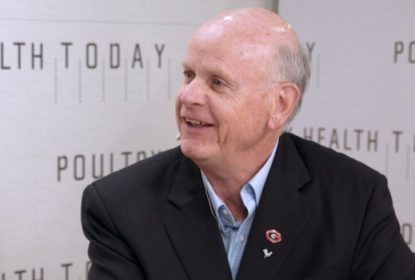
Antibiotic-free, Flock welfare, Global TOPICS, Interviews, News, PHT GLOBAL, PHT US, Podcast, TOPICS, Videos
... Coccidiosis control: Keys to success with a bioshuttle program
Oct 20, 2019Jennifer GrullonComments Off on Coccidiosis control: Keys to success with a bioshuttle program
Resistance is unlikely to be a problem in coccidiosis bioshuttle programs, Greg Mathis, PhD, Southern Poultry Research, told Poultry Health Today.... Necrotic enteritis control requires multi-pronged approach in RWA systems
Oct 17, 2019Jennifer GrullonComments Off on Necrotic enteritis control requires multi-pronged approach in RWA systems
Feeding higher levels of copper and zinc in the diet, managing litter moisture and controlling coccidiosis are keys to stopping necrotic enteritis (NE) in poultry raised without antibiotics (RWA),...... Avian pathogenic E. coli: Difficult to prevent and control
Oct 10, 2019Jennifer GrullonComments Off on Avian pathogenic E. coli: Difficult to prevent and control
The bacterium E. coli has re-emerged in broiler operations, which seems to coincide with poultry companies’ switch to ‘no antibiotics ever’ (NAE) programs.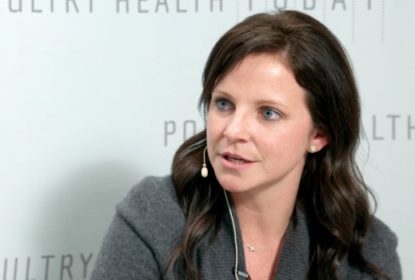
Diagnostics, Flock welfare, Global TOP NEWS, Infectious Diseases, Interviews, News, PHT GLOBAL, PHT US, Podcast, Respiratory, TOP NEWS, Videos
... Sentinel broilers, PCR testing help isolate, identify evolving IBV populations in Arkansas
Oct 07, 2019Jennifer GrullonComments Off on Sentinel broilers, PCR testing help isolate, identify evolving IBV populations in Arkansas
How do you look for new serotypes of a virus that might be circulating in an area? Sentinel birds are a good place to start, according to Abigail Reith, DVM, a technical services veterinarian for...... Reductions in medically important antimicrobials reflect industry stewardship
Oct 02, 2019Jennifer GrullonComments Off on Reductions in medically important antimicrobials reflect industry stewardship
Reductions in the use of medically important antimicrobials demonstrate the poultry industry’s commitment to stewardship of these valuable medications, Randall Singer, DVM, MPVM, PhD, told Poultry...
Antibiotic-free, Flock welfare, Global TOPICS, Interviews, News, PHT GLOBAL, PHT US, Podcast, Videos
... Helping contract growers’ transition to no-antibiotics-ever broiler production
Sep 29, 2019Jennifer GrullonComments Off on Helping contract growers’ transition to no-antibiotics-ever broiler production
Successful transition from conventional to no-antibiotics-ever (NAE) broiler production requires awareness of all the changes needed and lots of advance planning.... ‘Let’s keep it up’: Maintaining the efficacy of Zoamix®
Sep 25, 2019Jennifer GrullonComments Off on ‘Let’s keep it up’: Maintaining the efficacy of Zoamix®
TOOLBOX, Issue 15: An interview with Jon Schaeffer, DVM, PhD, Senior Director, Technical Services, US Poultry, Zoetis
Flock welfare, Global TOPICS, Interviews, News, PHT GLOBAL, PHT US, Podcast, Sustainability, TOPICS, Videos
... Better air circulation, moderately lower humidity improve paw quality
Sep 23, 2019Jennifer GrullonComments Off on Better air circulation, moderately lower humidity improve paw quality
Increasing air circulation coupled with moderate reductions in humidity can dramatically improve paw quality, Michael Czarick and Connie Mou, University of Georgia, told Poultry Health Today.... US poultry industry shifting focus to Campylobacter, Salmonella Infantis
Sep 19, 2019Jennifer GrullonComments Off on US poultry industry shifting focus to Campylobacter, Salmonella Infantis
The US poultry industry needs to revisit Campylobacter-control strategies in preparation for new performance standards coming from USDA’s Food Safety and Inspection Service, Ashley Peterson,...... Tips for ensuring best field vaccination results with Poulvac® ST or Poulvac® E. coli
Sep 12, 2019Jennifer GrullonComments Off on Tips for ensuring best field vaccination results with Poulvac® ST or Poulvac® E. coli
TOOLBOX, Issue 12: An interview with Lloyd Keck, DVM, ACPV, consulting veterinarian, on ensuring the best field vaccination results against Salmonella and E. coli.... Sprinkler systems benefit animal welfare, reduce water use
Sep 12, 2019Jennifer GrullonComments Off on Sprinkler systems benefit animal welfare, reduce water use
Sprinkler systems used in conjunction with cool cells during hot summer weather can not only benefit animal welfare, they can dramatically reduce water use.... Wet bulb reservoirs can be source of bacterial contamination for hatching eggs
Sep 10, 2019Jennifer GrullonComments Off on Wet bulb reservoirs can be source of bacterial contamination for hatching eggs
Wet-bulb reservoirs in hatchery incubators should be included in the bacterial-monitoring program to ensure they aren’t the source of egg-shell contamination.... Vaccinated birds shown to have lower incidence of Salmonella at processing
Sep 04, 2019Jennifer GrullonComments Off on Vaccinated birds shown to have lower incidence of Salmonella at processing
Broilers vaccinated against Salmonella showed reduced levels of the pathogen at processing in a recent study, according to Charles Hofacre, PhD, president, Southern Poultry Research Group. Inc.... Coccidiosis vaccination impedes nutrient digestibility
Aug 30, 2019Jennifer GrullonComments Off on Coccidiosis vaccination impedes nutrient digestibility
Poultry veterinarians and production managers are all too familiar with coccidiosis and its impact on gut health, nutrient absorption, feed conversion and growth rate.... What makes a chick tick: Help non-farm audiences understand poultry’s needs
Aug 29, 2019Jennifer GrullonComments Off on What makes a chick tick: Help non-farm audiences understand poultry’s needs
Rather than adopt costly production practices that don’t necessarily benefit the health or welfare of poultry, veterinarians should work to educate non-farm audiences about a bird’s inherent...... Poultry litter management key to MS control
Aug 28, 2019Jennifer GrullonComments Off on Poultry litter management key to MS control
Litter topped the list of environmental factors most consistently positive for Mycoplasma synoviae (MS), Naola Ferguson, DVM, associate professor at the University of Georgia, told Poultry Health...... Preharvest reduction of Salmonella, Campylobacter key to better control efforts
Aug 27, 2019Jennifer GrullonComments Off on Preharvest reduction of Salmonella, Campylobacter key to better control efforts
By Abhinav Upadhyay, DVM, PhD, postdoctoral associate and Dan J. Donoghue, PhD, professor, University of Arkansas... Preventive measures are only option for combatting key parasites in turkeys
Aug 19, 2019Jennifer GrullonComments Off on Preventive measures are only option for combatting key parasites in turkeys
Turkey producers will need to rely on preventive measures including biosecurity, good gut health and genetic selection to combat three key flagellated protozoan parasites that can affect their...... Zinc can help combat infectious bronchitis in poultry
Aug 14, 2019Jennifer GrullonComments Off on Zinc can help combat infectious bronchitis in poultry
Research on infectious bronchitis virus remains a top priority for the poultry industry. Not only is it widespread, but new serotypes also continue to emerge due to mutations and recombination events...... Water quality: No room for error in NAE flocks
Aug 13, 2019Jennifer GrullonComments Off on Water quality: No room for error in NAE flocks
By Tom Tabler, PhD, Extension Professor, Mississippi State University Extension Service, Poultry Science Department, Mississippi State, Mississippi... Report: US poultry producers slash use of medically important antimicrobials while shifting focus to disease prevention
Aug 08, 2019Jennifer GrullonComments Off on Report: US poultry producers slash use of medically important antimicrobials while shifting focus to disease prevention
US poultry producers dramatically decreased their use of medically important antimicrobials over a 5-year period ending in 2017, according to a new report released by Randall Singer, DVM, PhD,...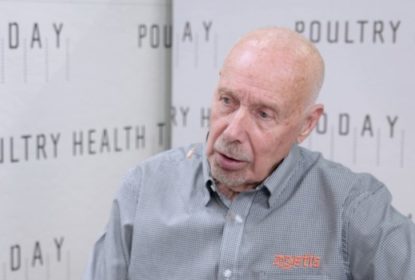
Antibiotic-free, Global TOP NEWS, Hatchery, Interviews, News, PHT GLOBAL, PHT US, Podcast, TOP NEWS, Videos
... Ensuring chick quality in NAE production
Jul 30, 2019Jennifer GrullonComments Off on Ensuring chick quality in NAE production
The increase in 7-day chick mortality that has come along with the elimination of antibiotics requires a focus on containing bacteria that start in the layer house.... Studies in chickens could lead to blackhead control in turkeys
Jul 26, 2019Jennifer GrullonComments Off on Studies in chickens could lead to blackhead control in turkeys
Broiler breeders are an ideal carrier for Histomonas — the cause of blackhead disease — but unlike turkeys that often die from the infection, broiler breeders survive.... Focus on these 4 areas to ensure broiler chick success
Jul 25, 2019Jennifer GrullonComments Off on Focus on these 4 areas to ensure broiler chick success
Faultless management in the first few days of a chick’s life is critical to ensuring birds remain healthy and productive for the rest of the crop.... Live-production management practices that help contain Salmonella
Jul 15, 2019Jennifer GrullonComments Off on Live-production management practices that help contain Salmonella
Avoidance of wet litter and well-timed feed withdrawal are two of several management steps that will help control the load of Salmonella going into the processing plant.... Focal duodenal necrosis in table-egg layers easily overlooked
Jul 15, 2019Jennifer GrullonComments Off on Focal duodenal necrosis in table-egg layers easily overlooked
Focal duodenal necrosis in table-egg layers can be an easily overlooked cause of drops in egg production and egg-case weight loss.... When vaccinating broilers against Salmonella may be worthwhile
Jul 09, 2019Jennifer GrullonComments Off on When vaccinating broilers against Salmonella may be worthwhile
Vaccinating broilers is a big investment and may not be needed on all farms, but it can be a worthwhile move if there are high loads of Salmonella coming into the processing plant.... Trial shows glutamine aids gut health in broilers raised without antibiotics
Jul 05, 2019Jennifer GrullonComments Off on Trial shows glutamine aids gut health in broilers raised without antibiotics
With the increase in no-antibiotic-ever production, glutamine may serve as a helpful nutrient asset, particularly when birds are under stress.... World poultry industry still struggling with necrotic enteritis
Jun 27, 2019Jennifer GrullonComments Off on World poultry industry still struggling with necrotic enteritis
NE remains a formidable challenge in broilers raised without antibiotics, and preventing the disease means steering clear of predisposing factors and implementing a rigid coccidiosis-control plan.... Zoetis Fast Tracking Relaunch of Avian Coryza Vaccine to Aid U.S. Disease Outbreaks
Jun 24, 2019Jennifer GrullonComments Off on Zoetis Fast Tracking Relaunch of Avian Coryza Vaccine to Aid U.S. Disease Outbreaks
Zoetis has reintroduced the vaccine Poulvac® Coryza ABC IC3 to help U.S. poultry producers combat outbreaks of avian coryza, an acute respiratory infection.... Maslow’s Pyramid: Self-actualization for chickens?
Jun 17, 2019Jennifer GrullonComments Off on Maslow’s Pyramid: Self-actualization for chickens?
By Philip A. Stayer, DVM, MS, ACPV, Corporate Veterinarian, Sanderson Farms, Inc.... On the road again? Don’t forget Poultry Health Today podcasts
Jun 14, 2019Jennifer GrullonComments Off on On the road again? Don’t forget Poultry Health Today podcasts
Most of Poultry Health Today’s video interviews with leading health experts and other opinion leaders can be downloaded as podcasts and listened to on mobile devices or through audio systems of...... Integrated plan with live production needed to meet new Salmonella standards
Jun 13, 2019Jennifer GrullonComments Off on Integrated plan with live production needed to meet new Salmonella standards
Poultry companies struggling to meet higher USDA standards for Salmonella need to increase control efforts in live production to help avoid the dreaded Category 3.... Pilgrim’s veterinarian shares experiences with NAE production
Jun 07, 2019Jennifer GrullonComments Off on Pilgrim’s veterinarian shares experiences with NAE production
Preparation, meticulous attention to sanitation and improved communication with hatchery staff and growers are critical for NAE production.... Four areas of hatchery management to help achieve better biosecurity
May 23, 2019Jennifer GrullonComments Off on Four areas of hatchery management to help achieve better biosecurity
Diligent attention to four areas of hatchery management — egg-pack quality, incubation, sanitation and in ovo vaccination — can go a long way.... A few tools to improve brooding, not antibiotic alternatives, are key to NE prevention
May 20, 2019Jennifer GrullonComments Off on A few tools to improve brooding, not antibiotic alternatives, are key to NE prevention
By Reg Smith, Vice President, Operations, Atlantic Poultry, Nova Scotia, Canada, Formerly Chair, British Poultry Council’s Antibiotic Stewardship strategy... Poultry producers facing higher hurdles with USDA food-safety standards
May 16, 2019Jennifer GrullonComments Off on Poultry producers facing higher hurdles with USDA food-safety standards
Poultry producers can expect to jump higher hurdles as USDA continues to raise the bar for food safety.... Moving up: Vaccinating broilers may help poultry companies improve Salmonella ratings
May 13, 2019Jennifer GrullonComments Off on Moving up: Vaccinating broilers may help poultry companies improve Salmonella ratings
Vaccinating broilers against Salmonella could be an effective live-side intervention for obtaining higher ratings in the Salmonella categorizations established by the USDA’s FSIS
Biosecurity, Global TOP NEWS, Infectious Diseases, Interviews, News, PHT GLOBAL, PHT US, Podcast, Respiratory, TOP NEWS, Videos
... Virulent ND in California sending wake-up call to US poultry industry
May 08, 2019Jennifer GrullonComments Off on Virulent ND in California sending wake-up call to US poultry industry
Outbreaks of virulent Newcastle disease (vND) that have spread from backyard to commercial flocks in California are providing a wake-up call to the entire US poultry industry.... More than half of US broilers raised without antibiotics in 2018
May 06, 2019Jennifer GrullonComments Off on More than half of US broilers raised without antibiotics in 2018
Broilers raised without antibiotics accounted for 51% of total US production in 2018 — an 11-point jump from the previous year and, more significantly, up from 3% in 2014.... Bioshuttle program helps control E. tenella outbreaks in pullets
May 02, 2019Jennifer GrullonComments Off on Bioshuttle program helps control E. tenella outbreaks in pullets
Administration of an in-feed anticoccidial after coccidiosis vaccination has helped alleviate outbreaks of Eimeria tenella in broiler breeder replacement stock.... Hatchery hygiene helps limit broiler E. coli mortality risk
Apr 24, 2019Jennifer GrullonComments Off on Hatchery hygiene helps limit broiler E. coli mortality risk
Disinfecting eggs and improving overall hygiene in the hatchery could dramatically reduce the risk of mortality linked to E. coli infections, scientists say.... Aggressive vaccination of broiler breeders needed to keep reovirus in check
Apr 18, 2019Jennifer GrullonComments Off on Aggressive vaccination of broiler breeders needed to keep reovirus in check
Aggressive vaccination of broiler breeders for reovirus using live and inactivated vaccines has been one of the most important steps the US poultry industry has taken to maintain good protection...... Life without antibiotics: Field lessons learned the hard way
Apr 15, 2019Jennifer GrullonComments Off on Life without antibiotics: Field lessons learned the hard way
Producers need to think long and hard before jumping into “no antibiotics ever” (NAE) poultry production.


